For those who love collecting historic equipment for sport and recreational diving, one of the main reasons that often make it impossible to find samples in a decent state of conservation is the aging of the rubber parts. This phenomenon is particularly serious, especially for those components of equipment that were built using natural rubber, i.e. mainly fins and masks. This material has been submitted to several improvements over the years and developed in many different variants (e.g. nitrile, neoprene, silicone, Viton, etc.). The natural rubber used in the construction of these masks and fins, despite its excellent characteristics in terms of mechanical resistance and elasticity, was very vulnerable to the action of UV rays and ozone with the tendency of hardening or producing cracks due to oxidation processes of the rubber itself. Therefore, it is quite difficult to find rubber products manufactured in the early years of the history of sport diving (especially the 1950s and 1960s) that have acceptable conservation characteristics and can be included in an exhibition or museum.
Sometimes, however, it is possible to find samples that, despite the significant number of years from the production date, are still in good condition. This is normally due to three factors: the high quality of the rubber used in manufacturing, the very limited use and the conservation of the units in places protected from direct sun exposure. This is the case of a sample of the mask model produced by Pirelli since the early 1950s and called “Nereide”, a model that I luckily found and purchased few years ago (see Figure 1, Figure 2, Figure 3 and Figure 4).
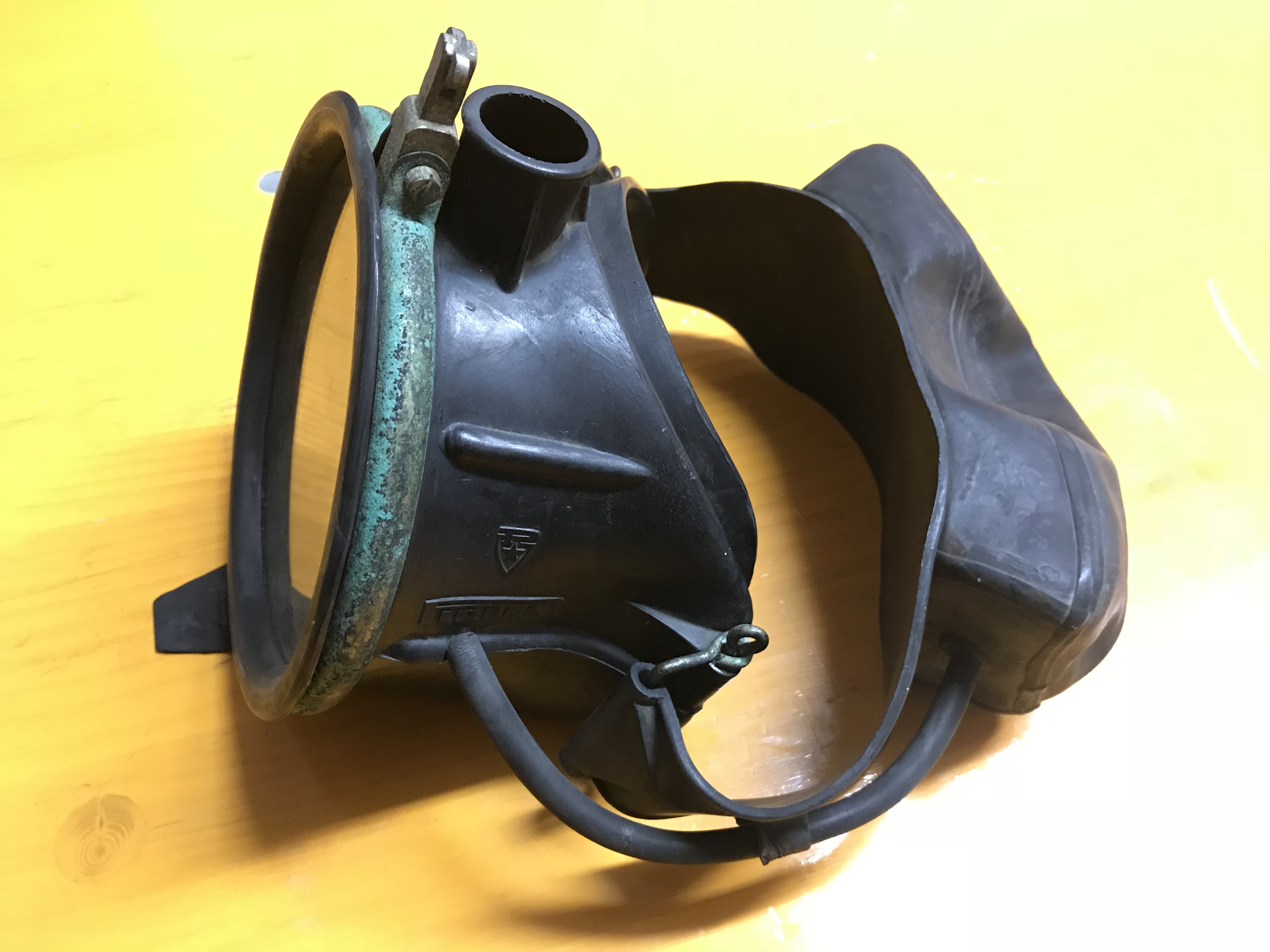 |
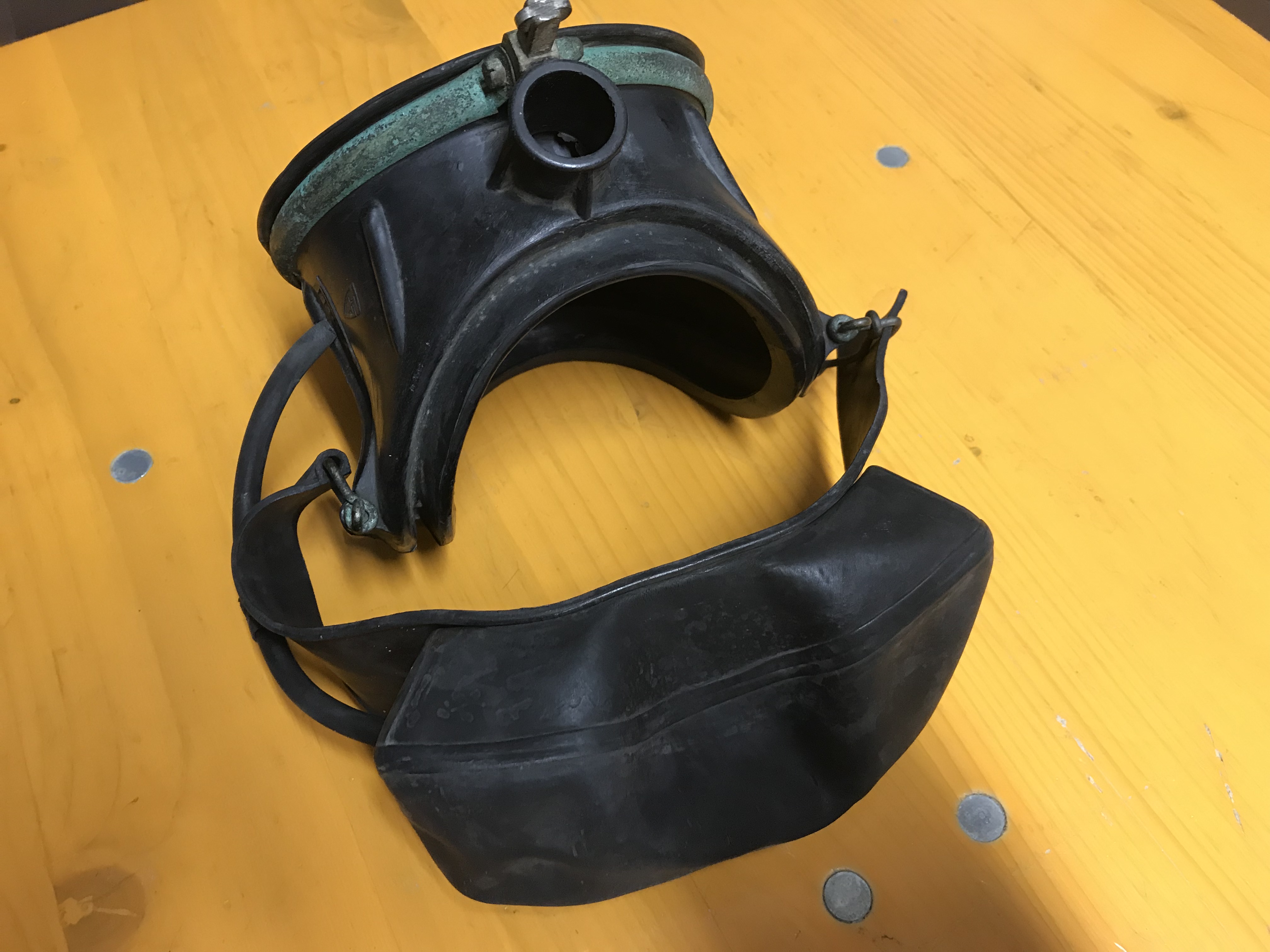 |
| Figure 1 |
Figure 2 |
This model remained in production for several years (we still find it in the 1969 Pirelli catalogue) and has undergone various modifications and improvements following the availability of new materials and technologies and the users’ feedback. The sample from my collection in particular is designed to cover also the diver’s mouth and is equipped with a hydrostatic pressure compensation device consisting of a small rubber lung located on the back of the mask head-strap. This lung is pneumatically connected to the internal volume of the mask through a small rubber pipe placed on the mask left side. A small duckbill valve is provided in the lower part of the mask body with the function of draining the water penetrated inside the mask (see Figure 4).
This model was classified by my friend Luigi Fabbri, a SCUBA diving journalist, writer and collector, as "Nereide First Series" and the year of production start was identified as 1952. You can find pictures and basic information of this model on his website www.blutimescubahistory.com, one of the most complete website in the world dedicated to historical diving equipment. We are talking about a unit that is more than seventy years old and therefore very rare also for the reasons of rubber deterioration explained previously.
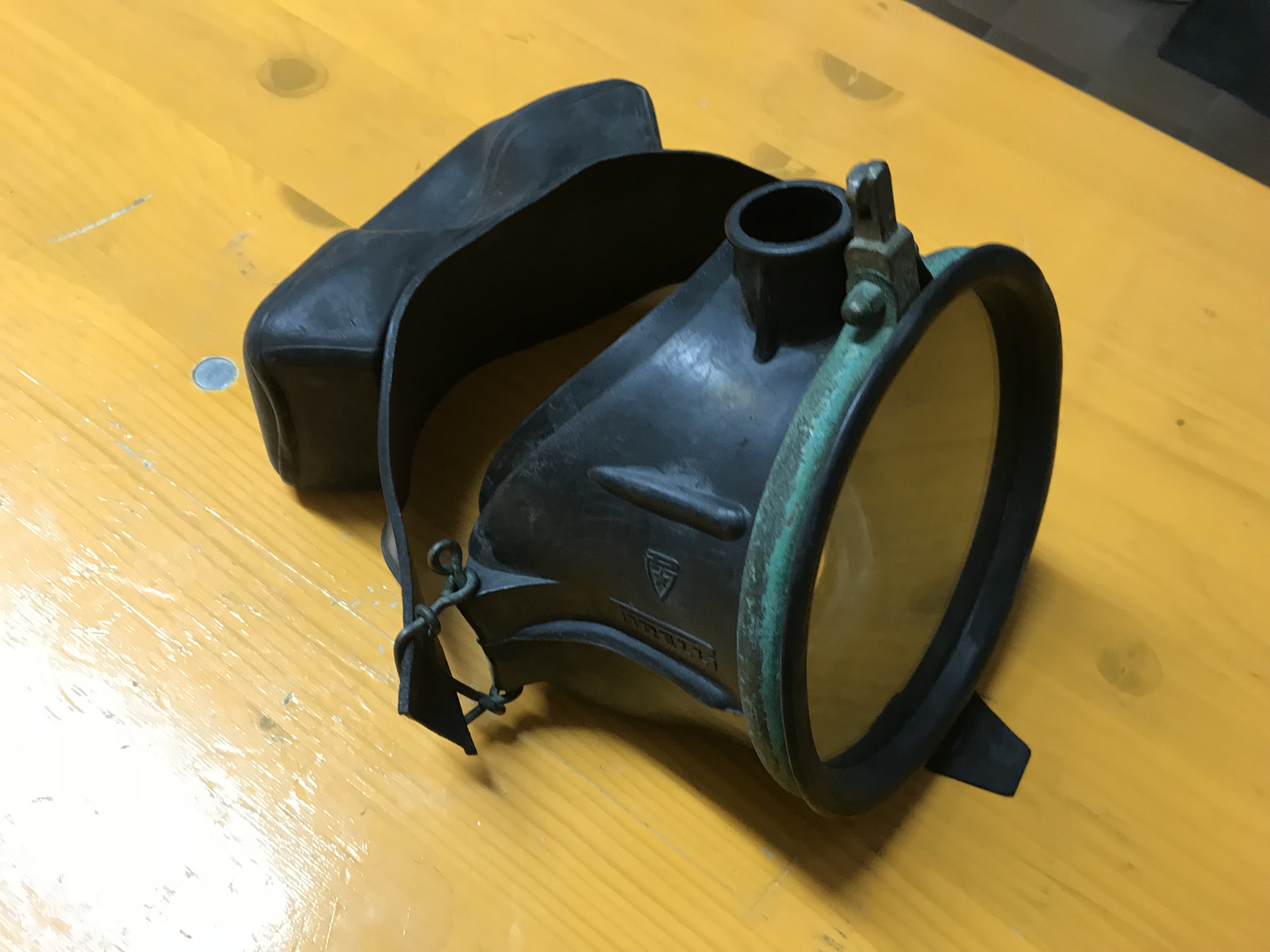 |
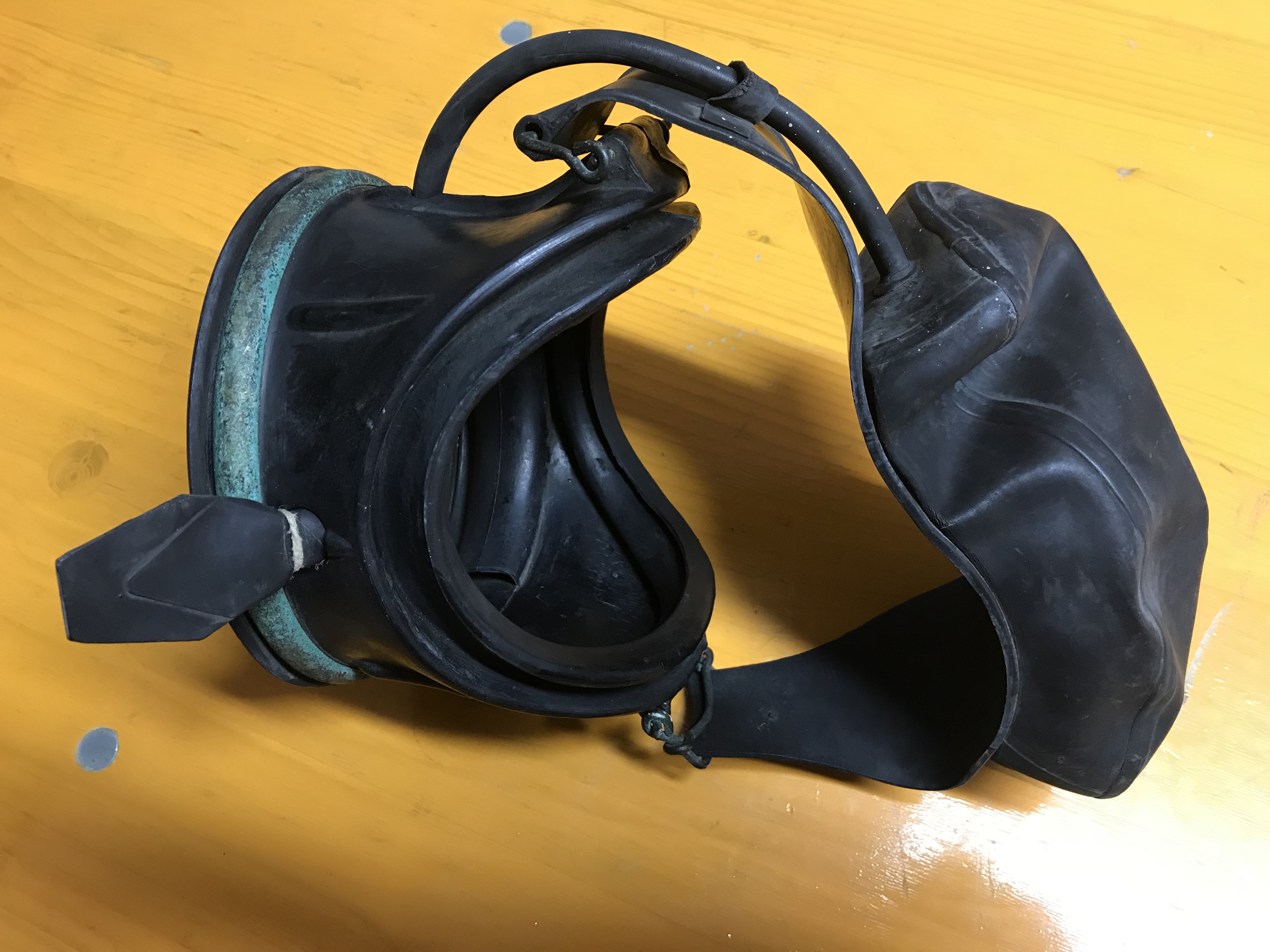 |
| Figure 3 |
Figure 4 |
Browsing the net and consulting old books on diving history and techniques I was able to find only a couple of photos showing this mask model in real diving contexts (see Figure 5 and Figure 6).
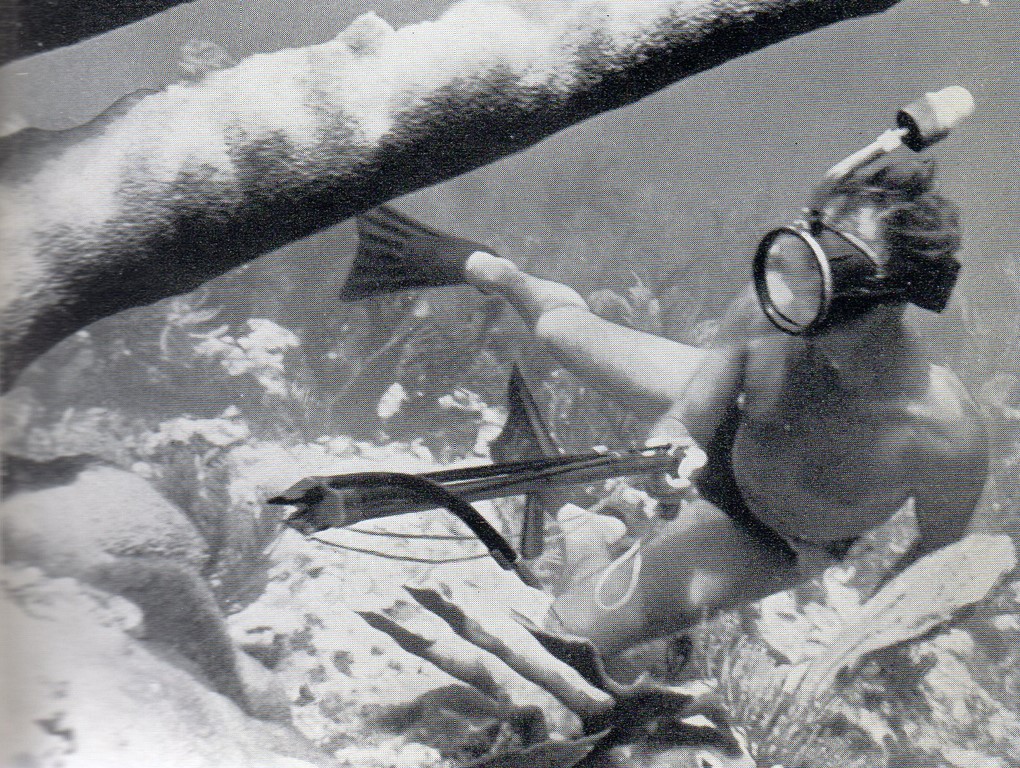 |
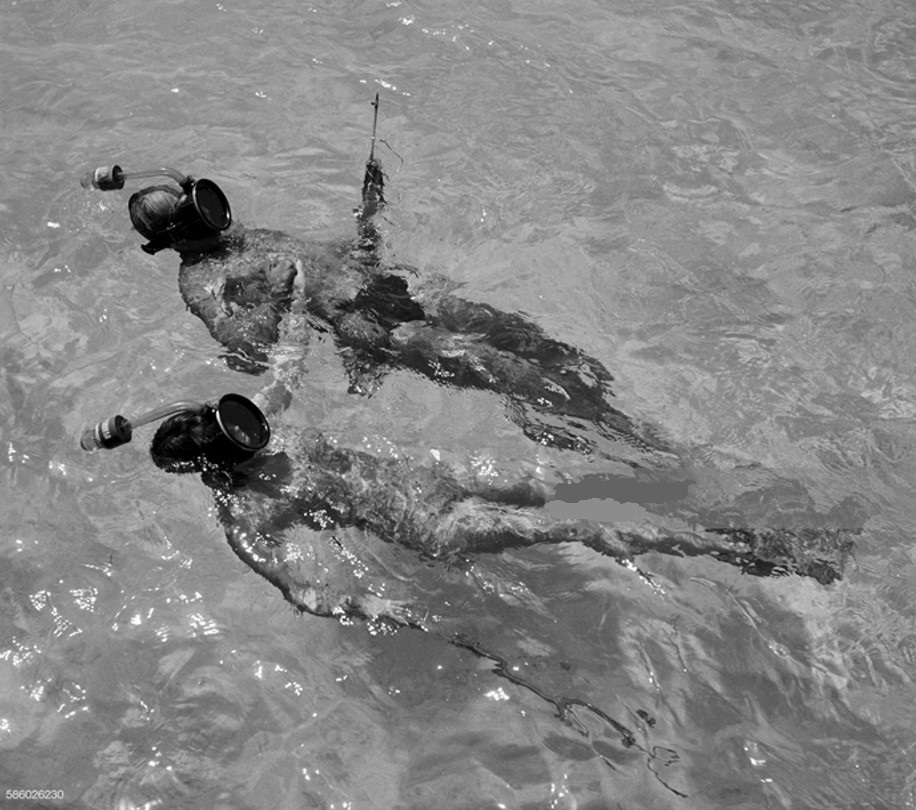 |
| Figure 5 |
Figure 6 |
Unfortunately, the mask in my collection has the snorkel missing, including its typical pad floating valve, and the end part of its head-strap was cut on the right side (see Figure 3). I wondered for a long time if and how I could restore and complete this mask but without reaching a definitive conclusion, not having sufficient information and materials available to decide on a reasonable course of action. However, one of the main virtues of a collector is that of patience and knowing how to seize opportunities when they arise without being overwhelmed by the rush or sense of urgency that is typical of most work experiences. This is entirely in line with the very nature of collecting which, being a hobby, must above all provide pleasure and not further pressure or stress. And also in this case the right opportunity showed up few months ago when I managed to purchase another sample of the “Nereide” mask but more recent than the first one and without the external pressure compensation device (see Figure 7, Figure 8, Figure 9 and Figure 10).
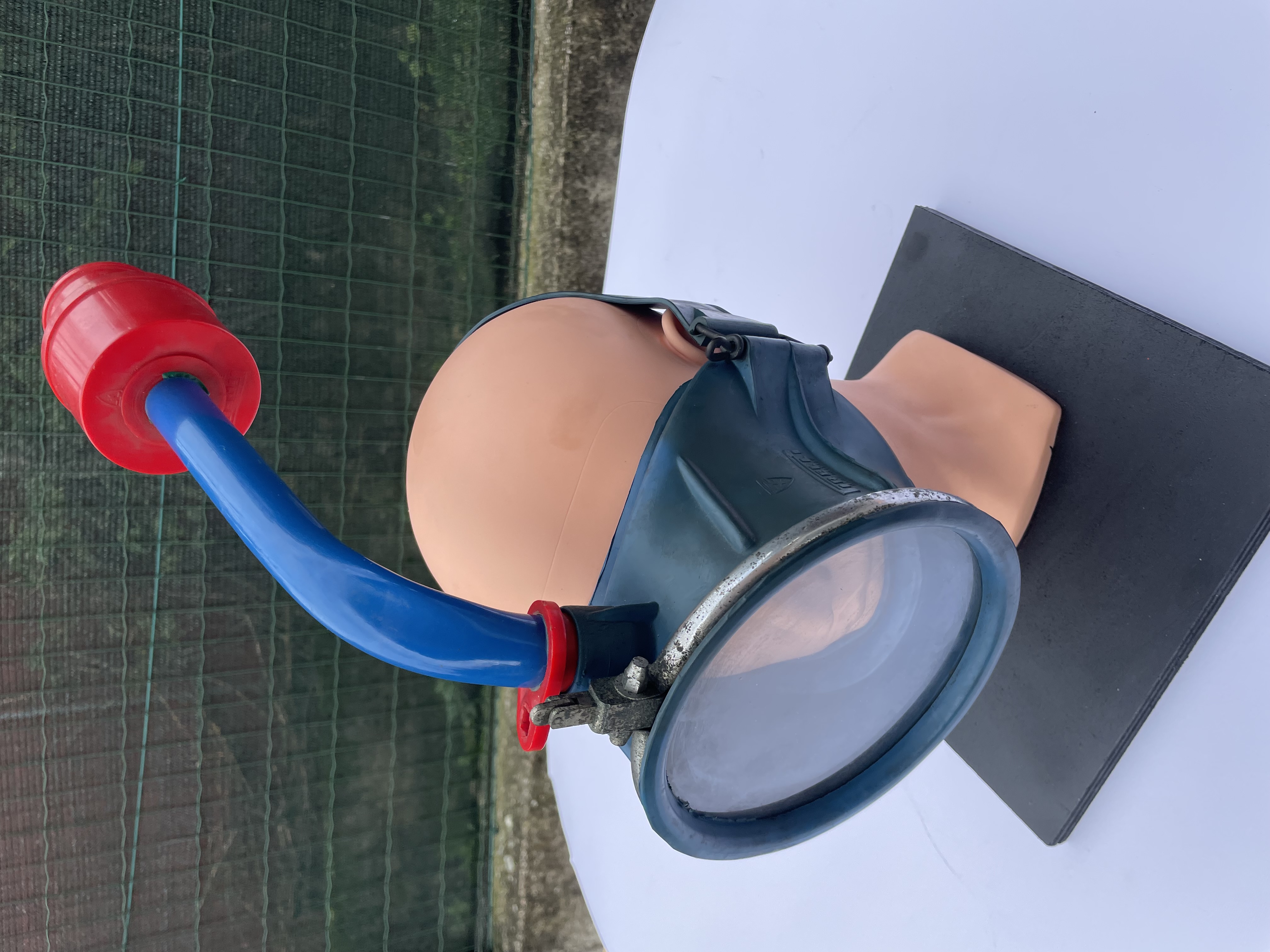 |
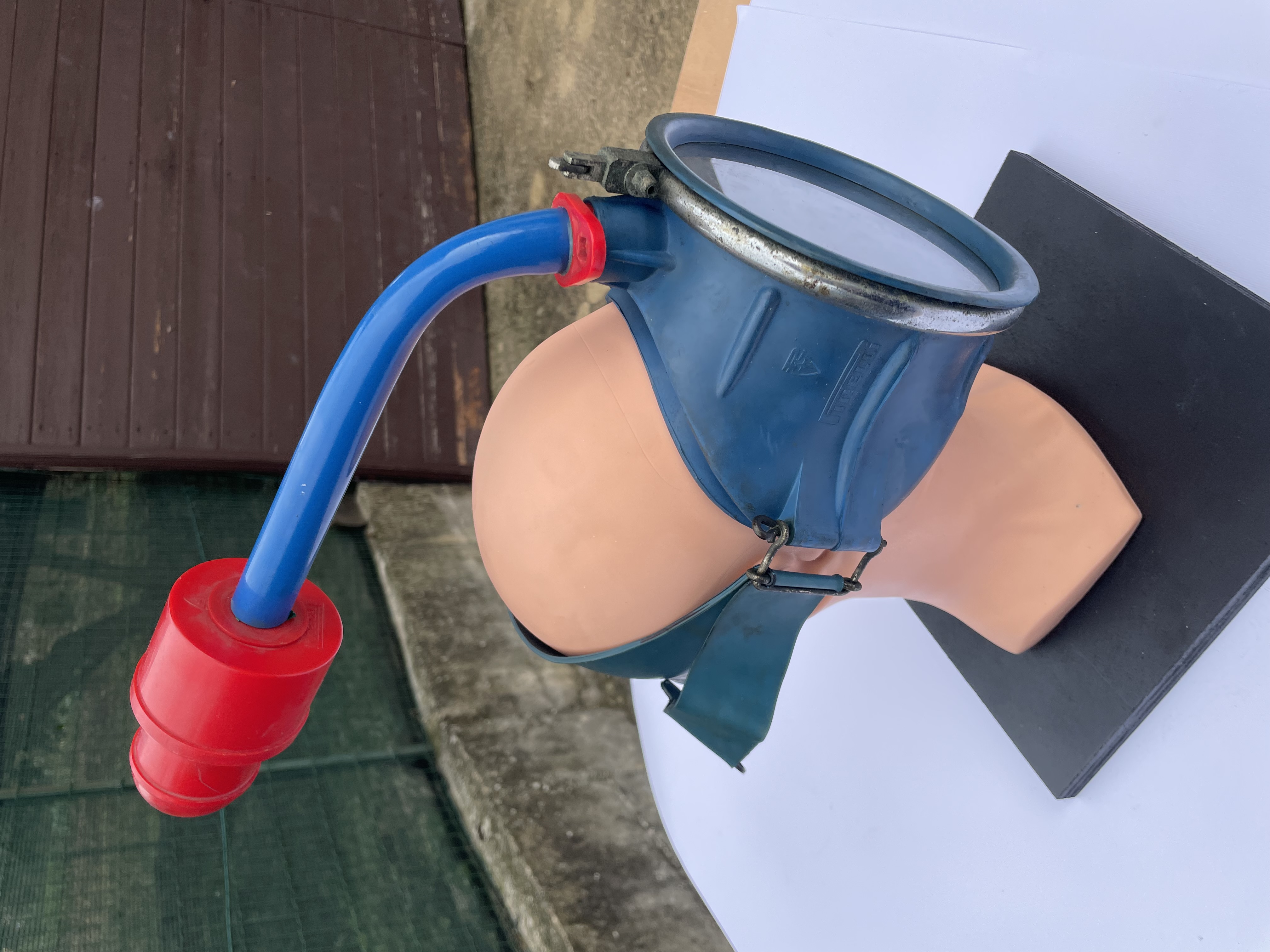 |
| Figure 7 |
Figure 8 |
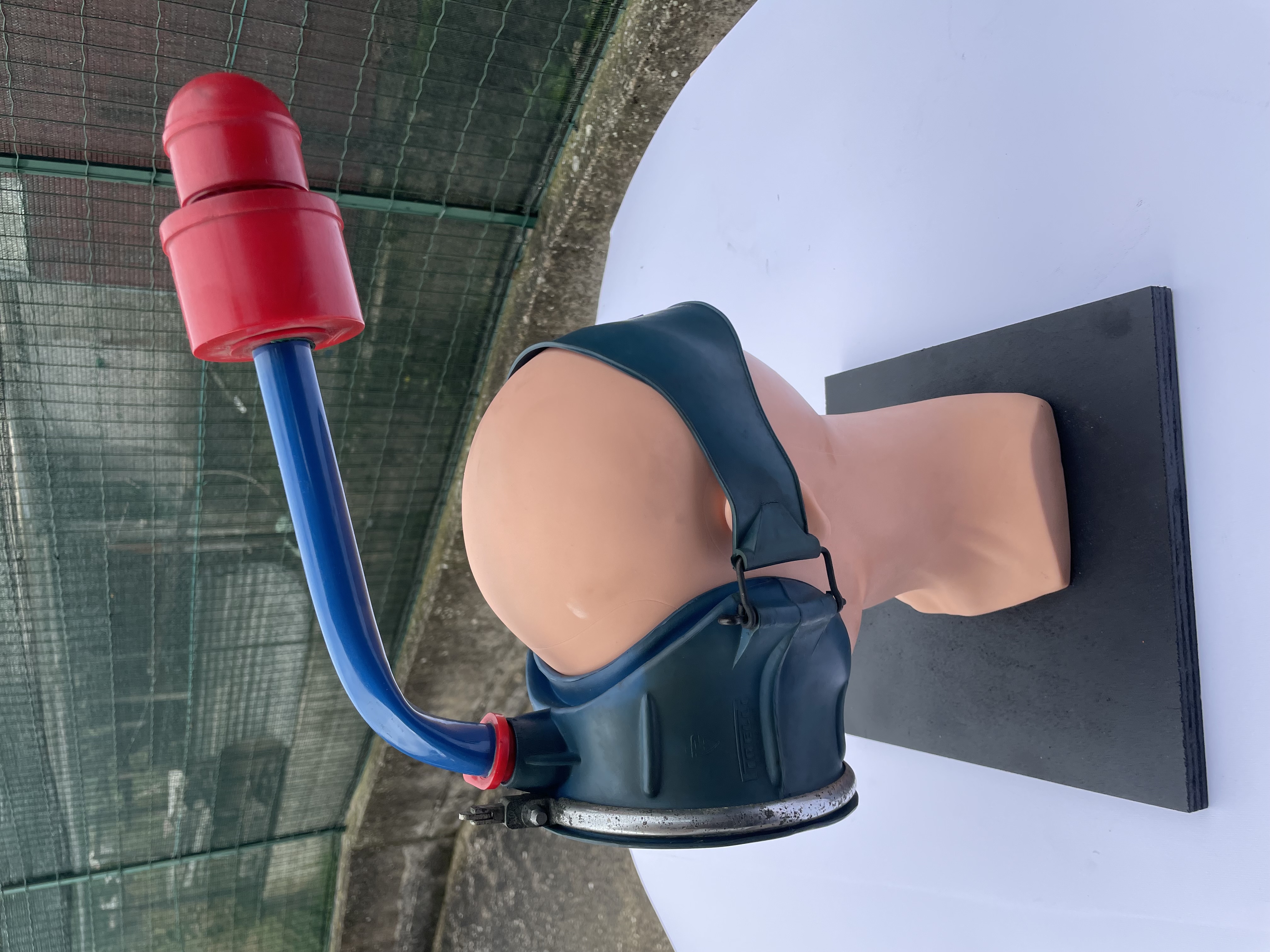 |
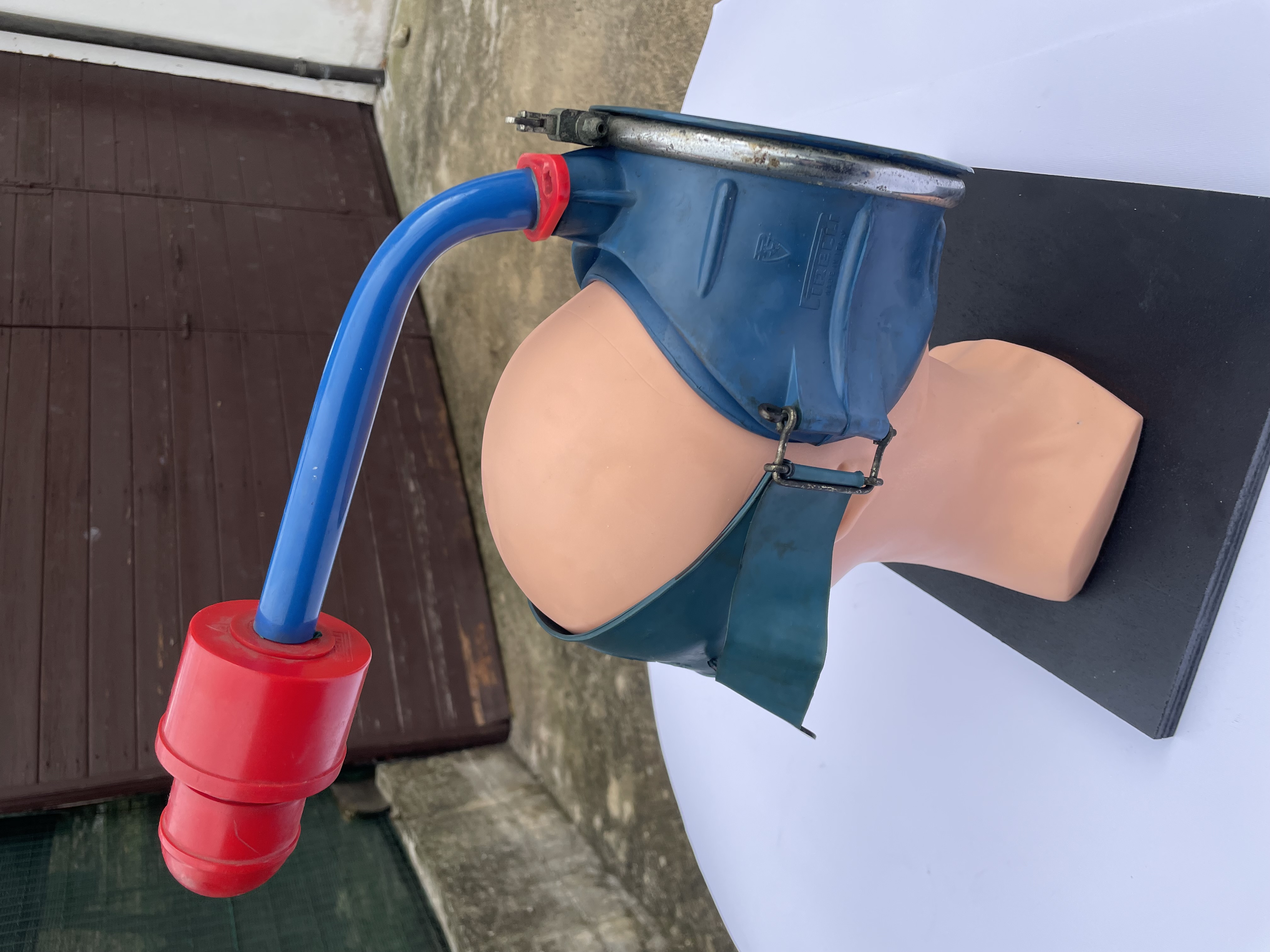 |
| Figure 9 |
Figure 10 |
This sample, made of blue rubber unlike the masks of the first series which were made of black rubber, is complete with snorkel and pad floating valve and has an intact head-strap. In particular, the pad floating valve was part of patents n° 2,488,261 in 1949 and n° 2,534,568 in 1950, filed in the USA by Pirelli (see Figure 11 and Figure 12) and based on inventions by Nerino Bedini (probably one of the employees of Pirelli itself). The first of the two patents referred in particular to the “Poseidon” model oxygen rebreather (ARO) (see Figure 13) while the second was designed for the “Oceanina” mask (see Figure 14) and all subsequent models that would have used the same type of snorkel and pad floating valve.
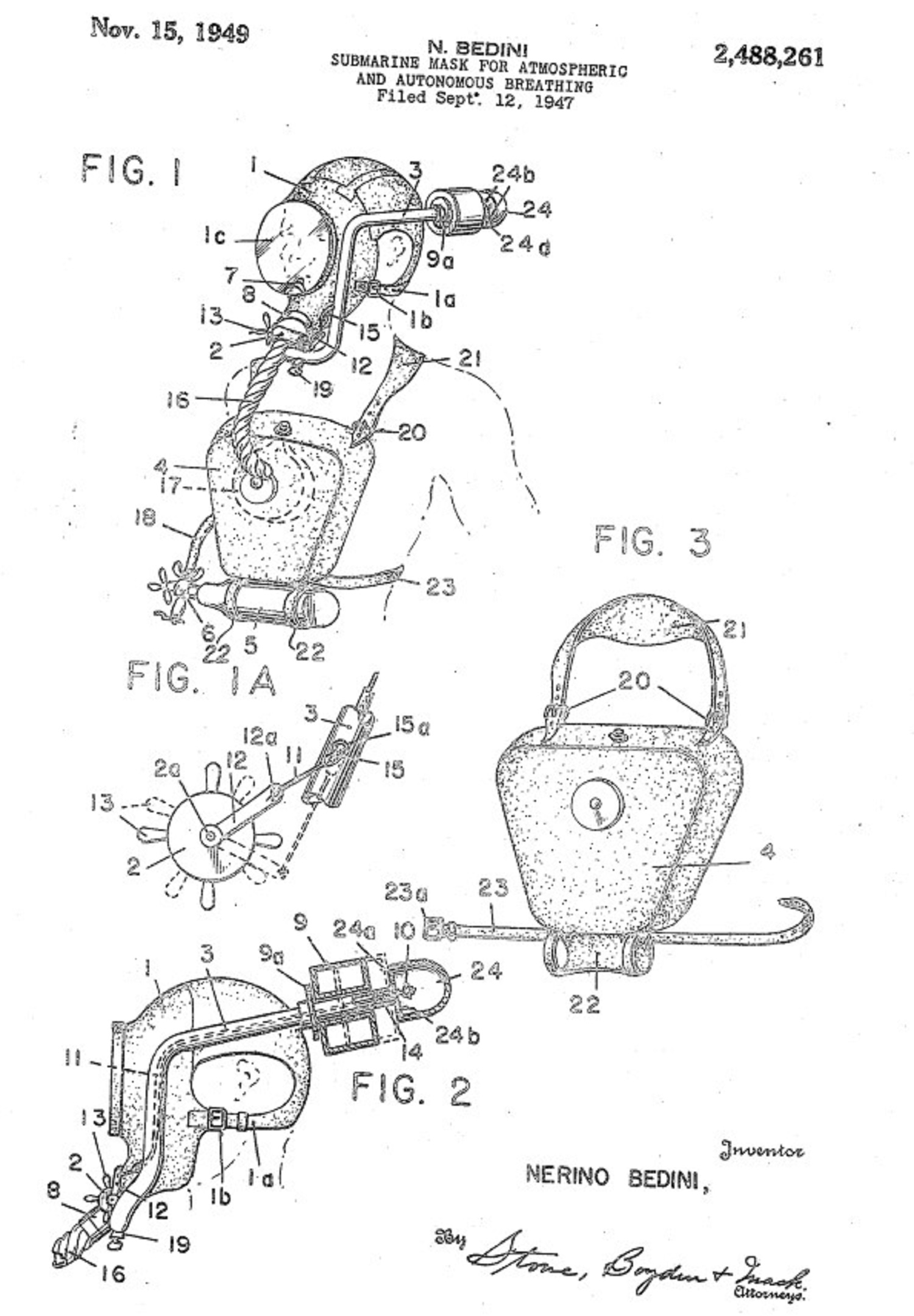 |
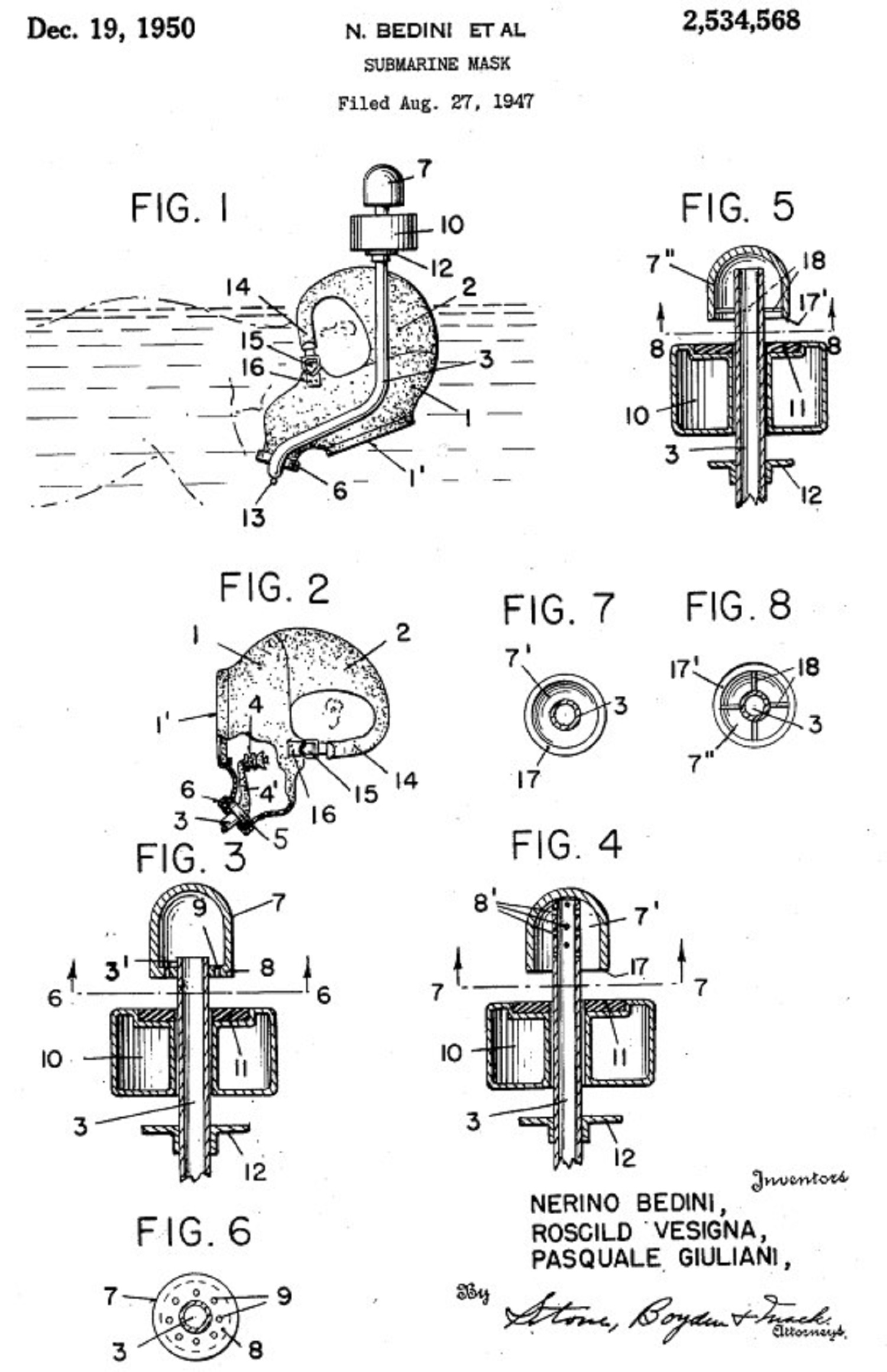 |
| Figure 11 |
Figure 12 |
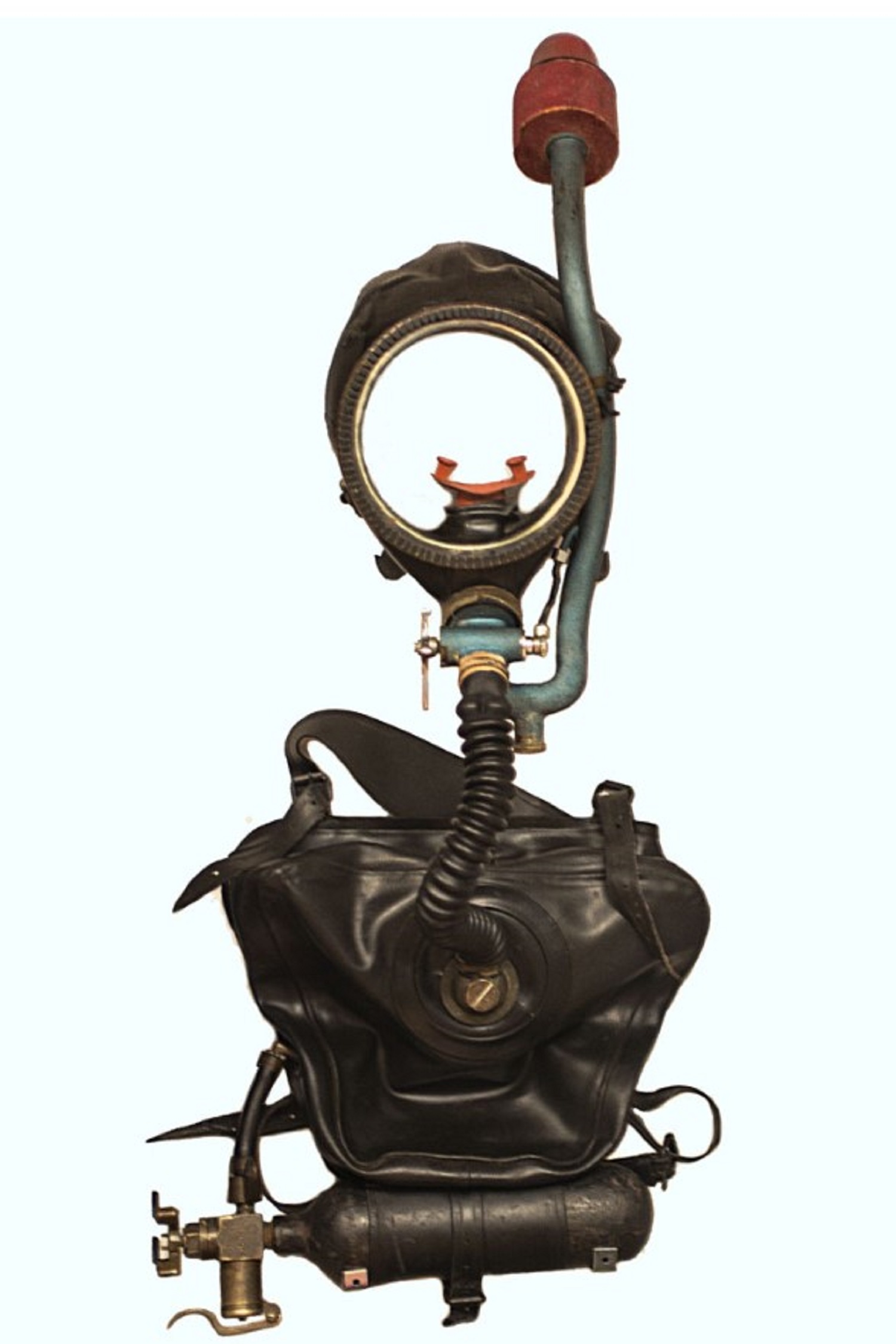 |
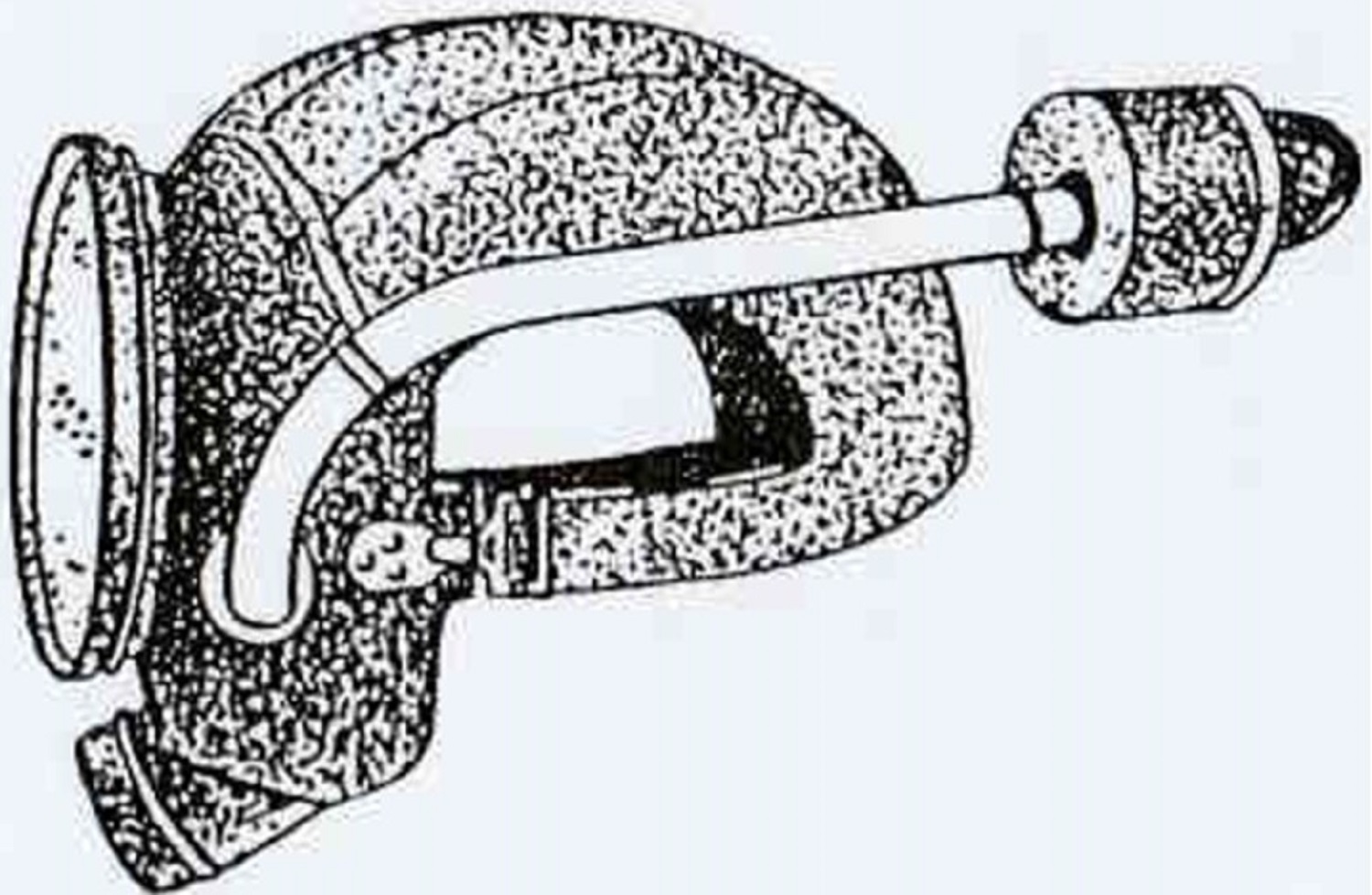 |
| Figure 13 |
Figure 14 |
I now had a real physical sample available to obtain information on the dimensions and construction characteristics of the missing parts (see Figure 15 and Figure 16).
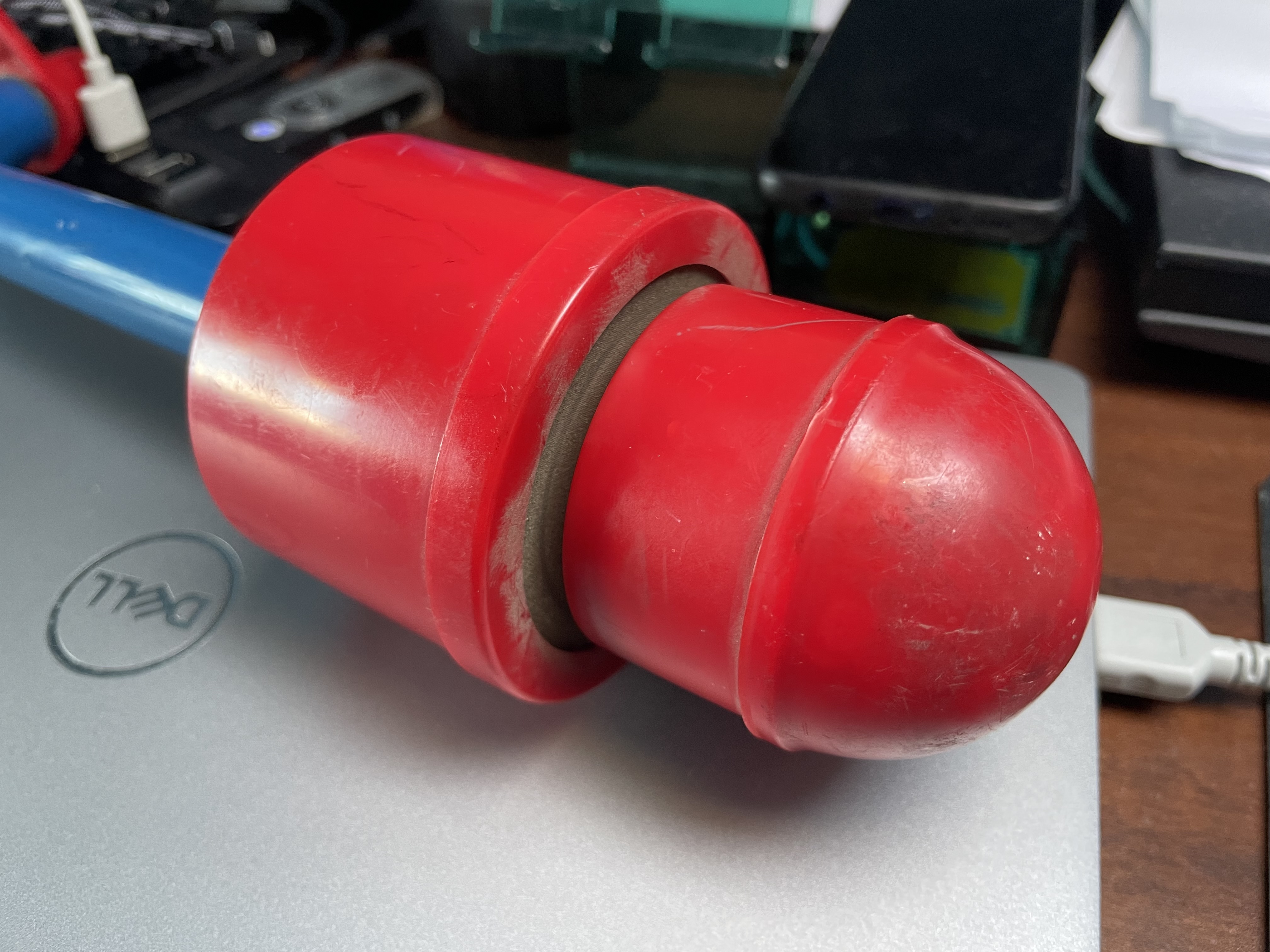 |
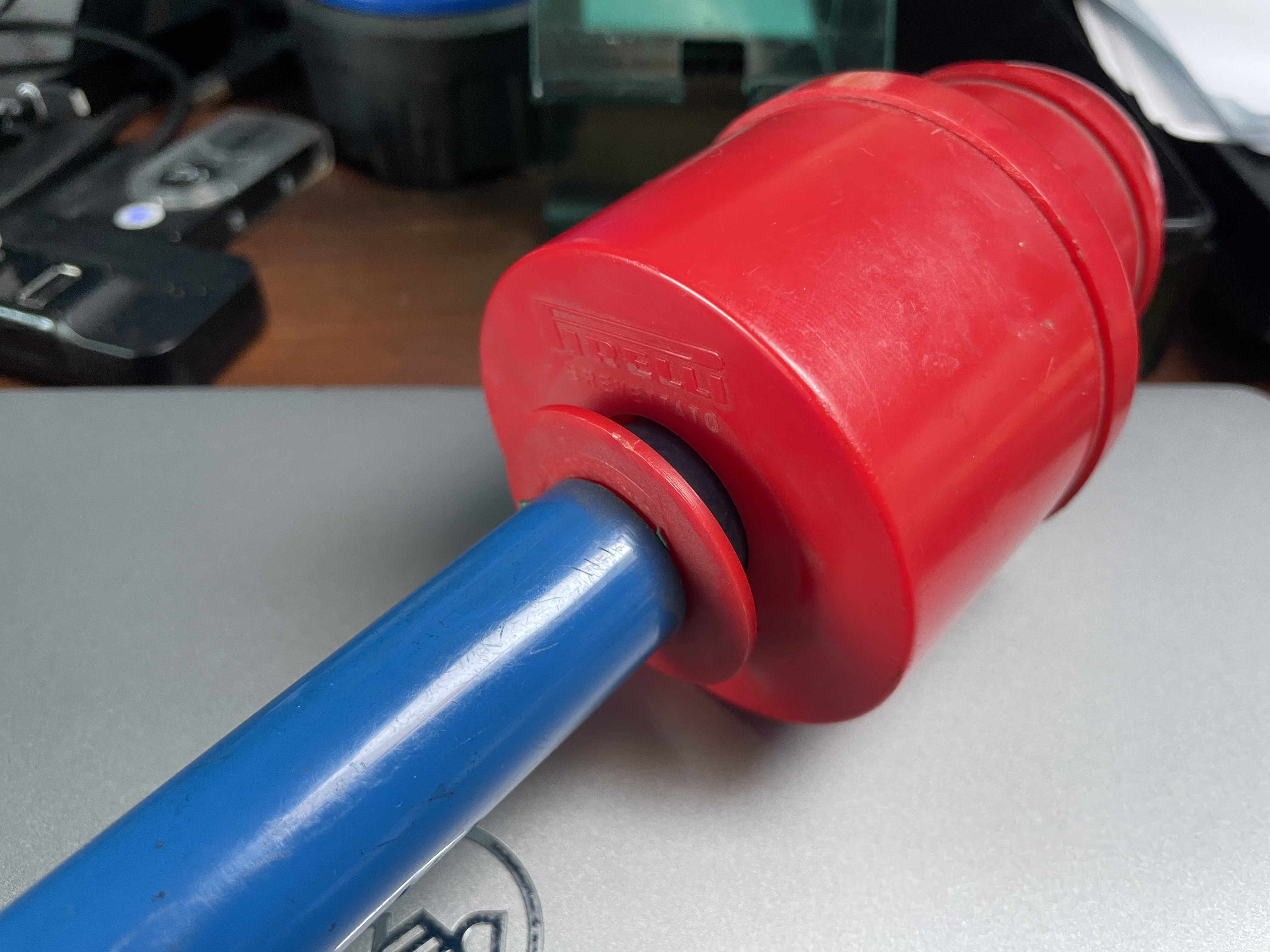 |
| Figure 15 |
Figure 16 |
Measuring the components of the pad floating valve with a caliper and micrometer allowed me to create 3D CAD models (see Figure 17, Figure 18, Figure 19 and Figure 20).
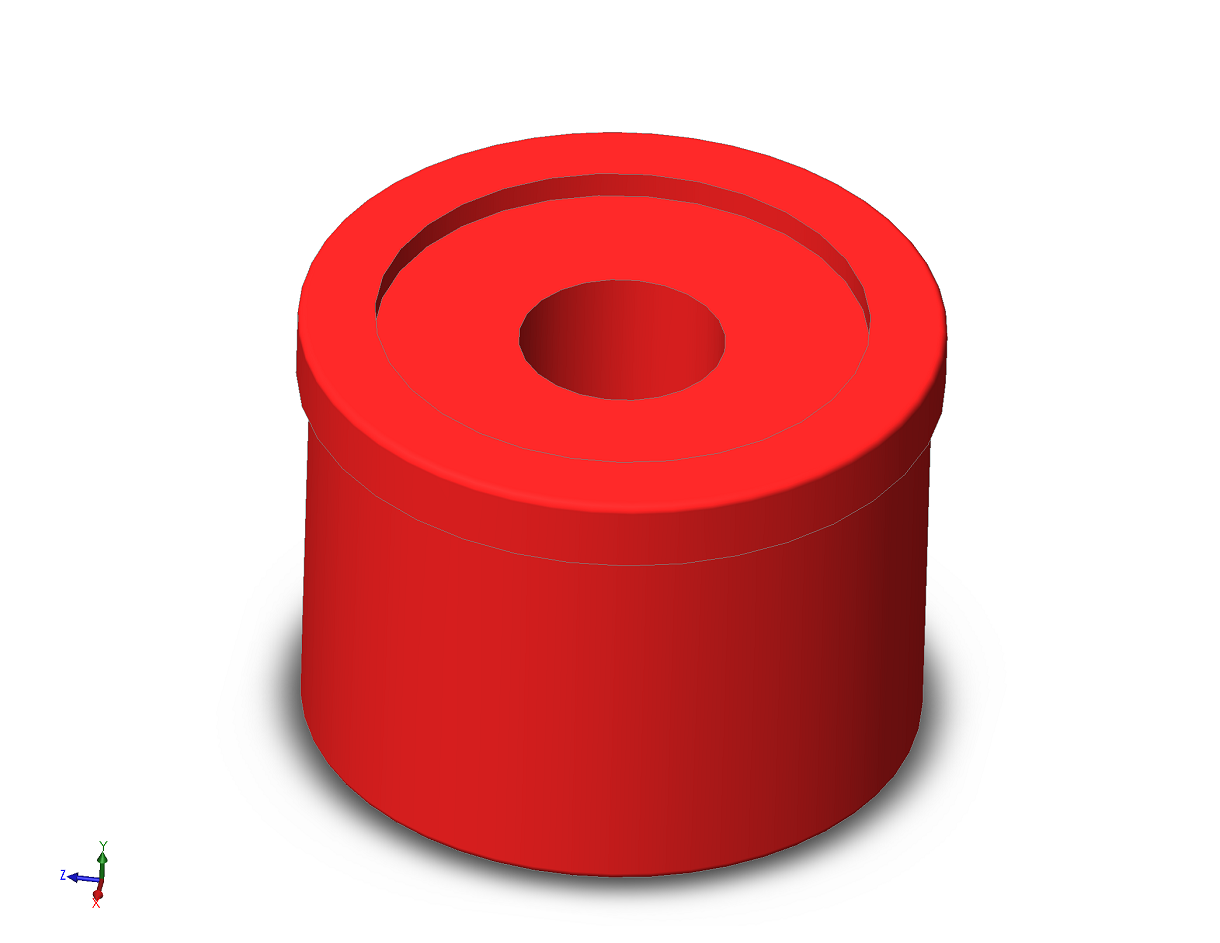 |
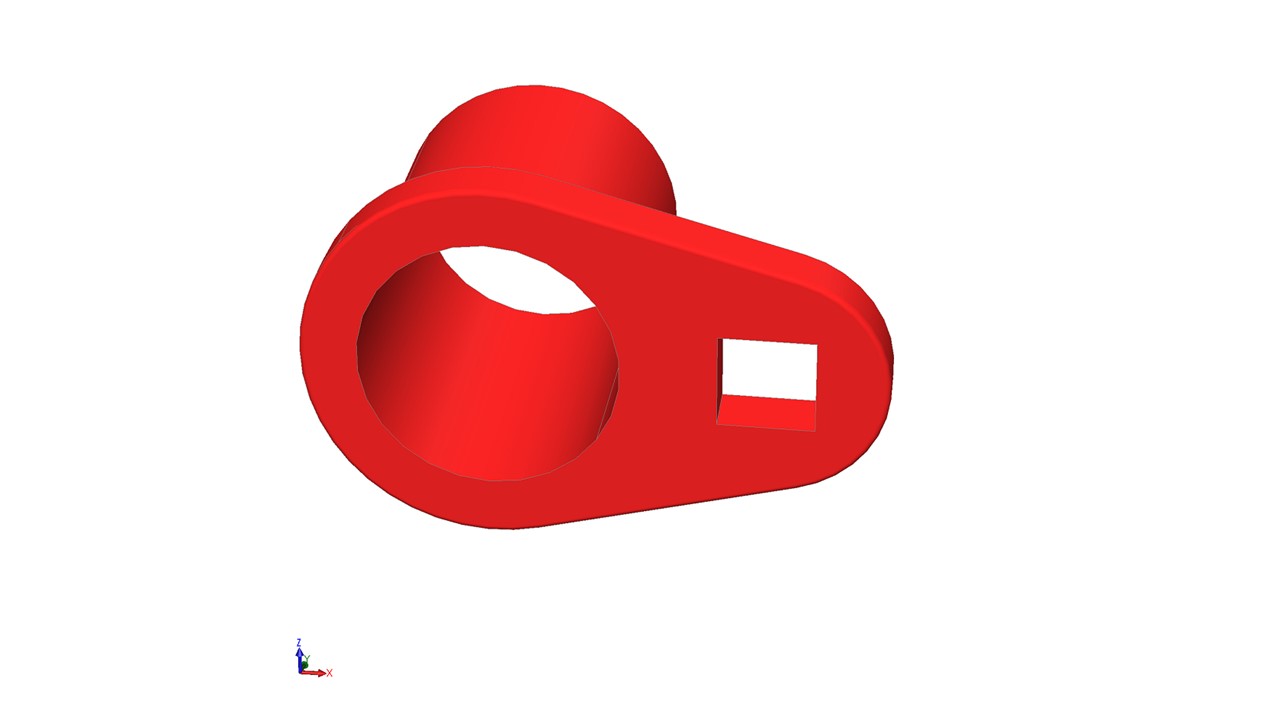 |
| Figure 17 |
Figure 18 |
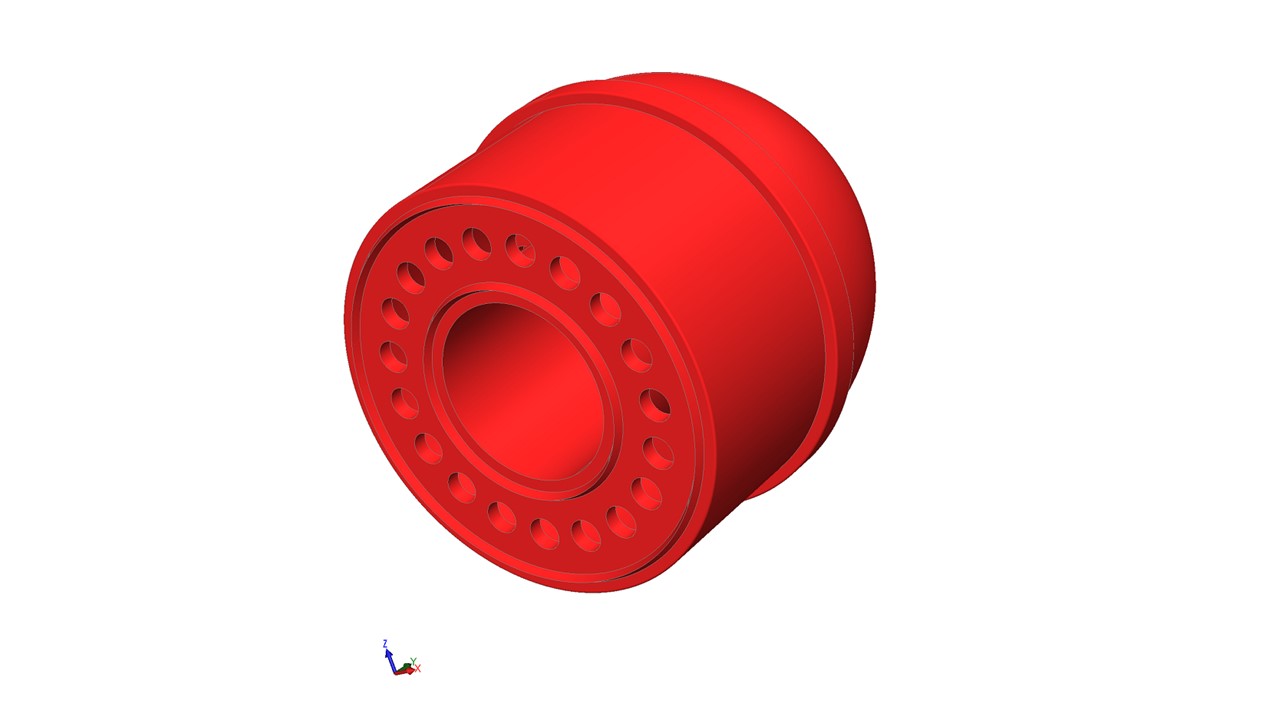 |
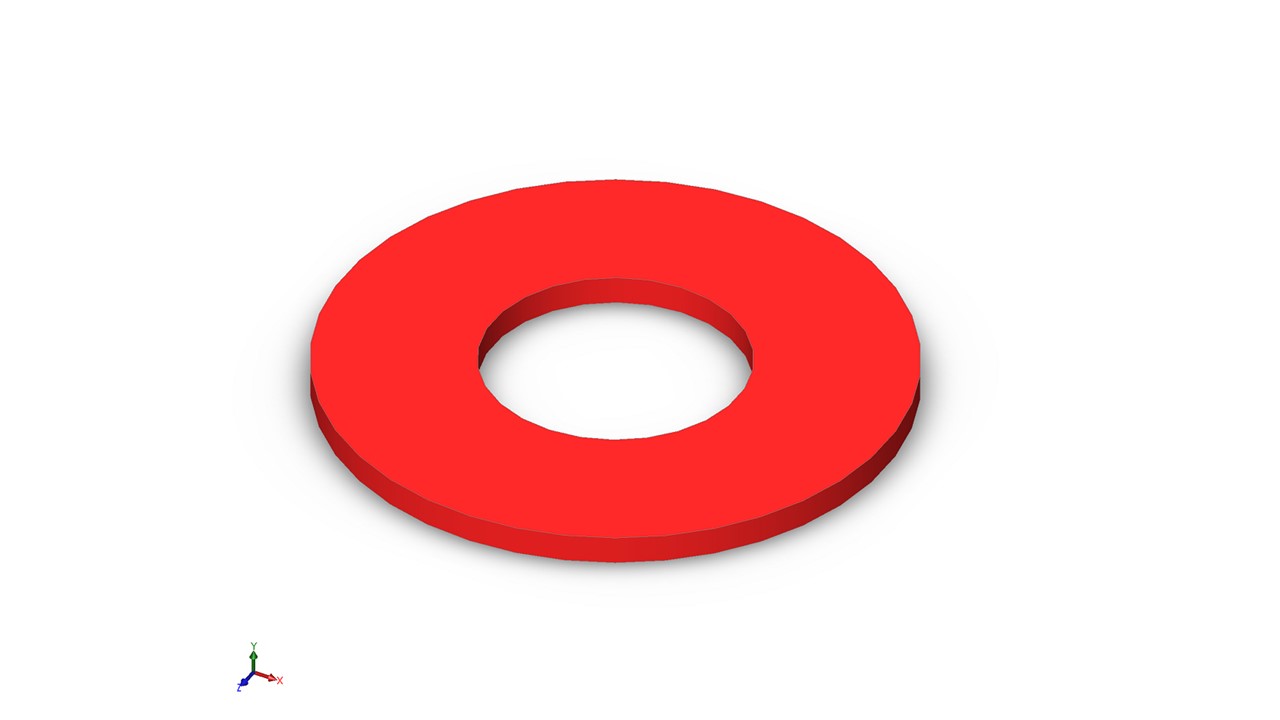 |
| Figure 19 |
Figure 20 |
At this point I looked for someone who was able to create 3D physical parts using the rapid prototyping printers available on the market today. Also in this case, offers abound on eBay and, in particular, I found a 3D printing provider capable of making samples in red resin, which is the color of the valve components, and having surface characteristics practically the same as the original parts (I preferred the resin type printing instead of filament type printing due to the reduced surface roughness that can be obtained). The parts thus created using the 3D resin printer are shown in Figures 21 and 22.
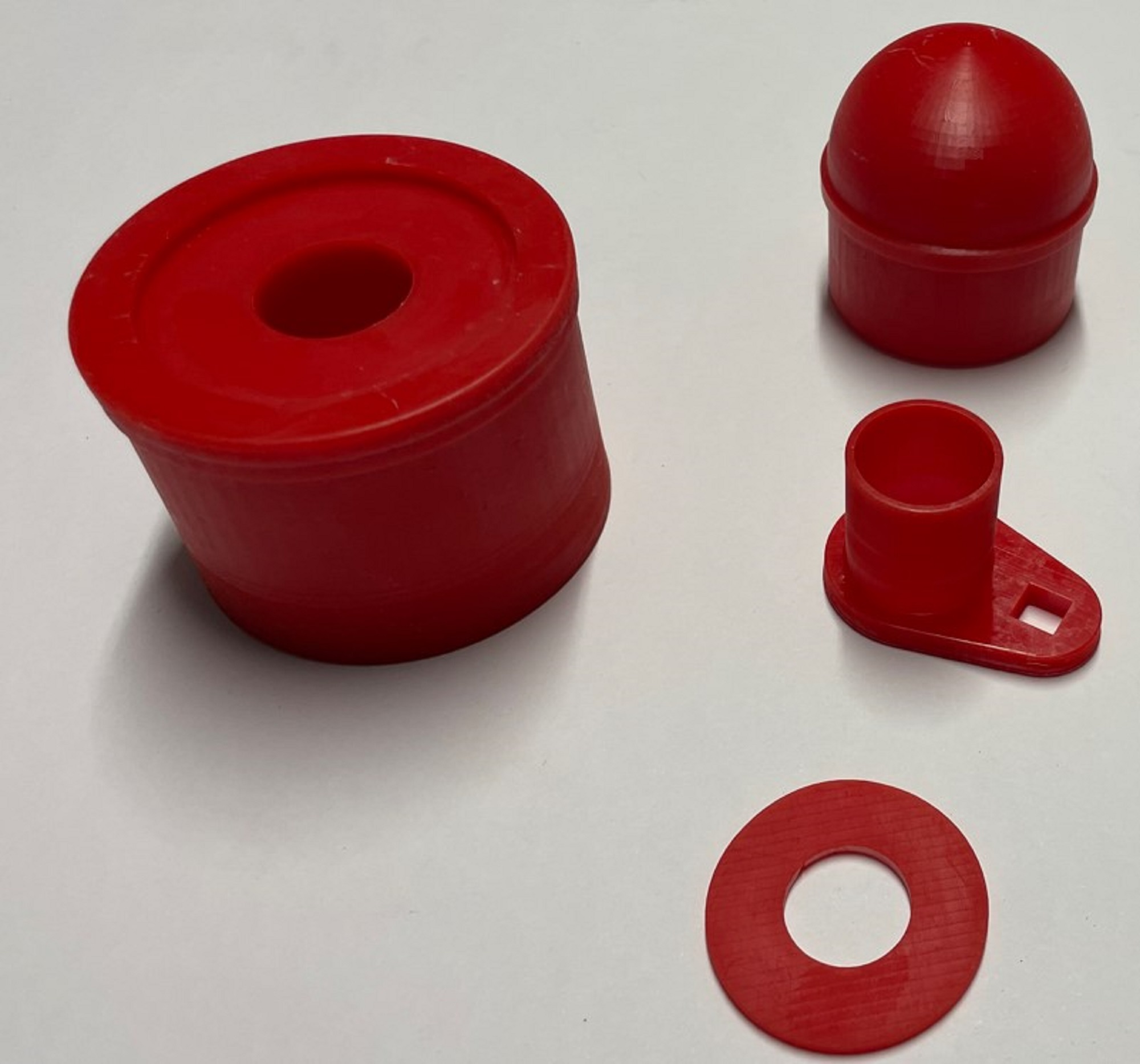 |
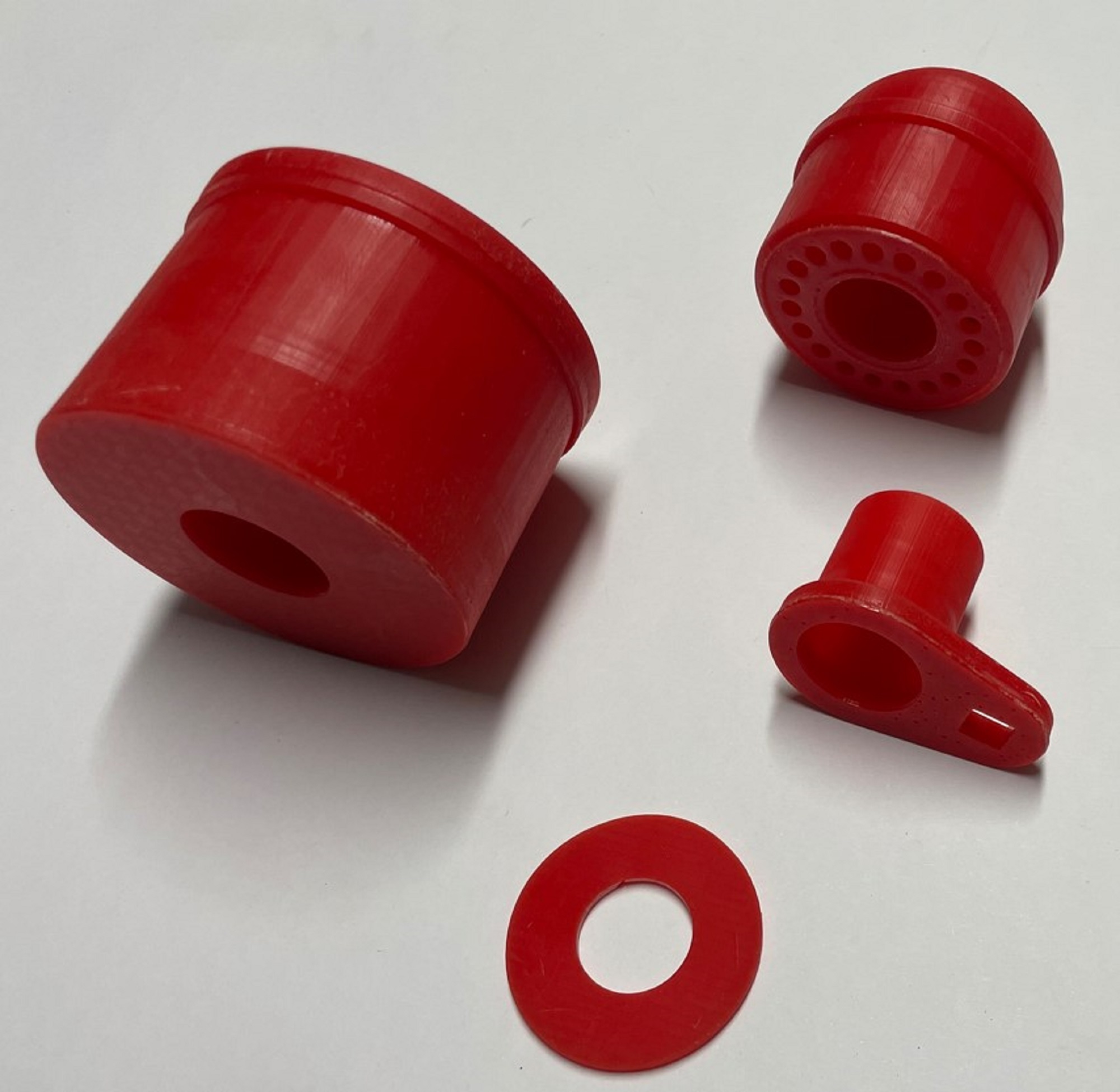 |
| Figure 21 |
Figure 22 |
I was quite satisfied with the result achieved but there was something that still didn't completely convince me. In fact, observing the very few photos available on the Internet, I noted that the construction of the pad floating valve had undergone significant changes from the first models of the early 1950s to those of the following years when the second sample of the "Nereide" blue mask was probably manufactured. In particular, as can be seen in Figure 23 and Figure 24, the lower floating part of the valve was made by cork which was then painted in red color and finally provided with the silver painted “Pirelli” brand. In addition, a rubber disc was mounted on the upper surface of the floating pad and held in place by a ring, presumably made in aluminum, and secured to the floating cork body by small screws. The function of the rubber disc, which would then be maintained in all the next versions of the valve, was to improve its water tightness when it was in the closed position underwater.
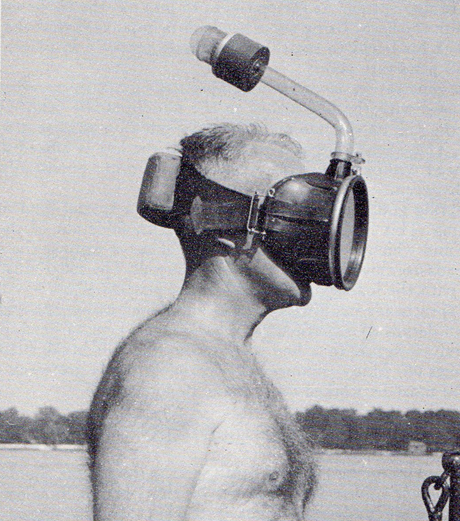 |
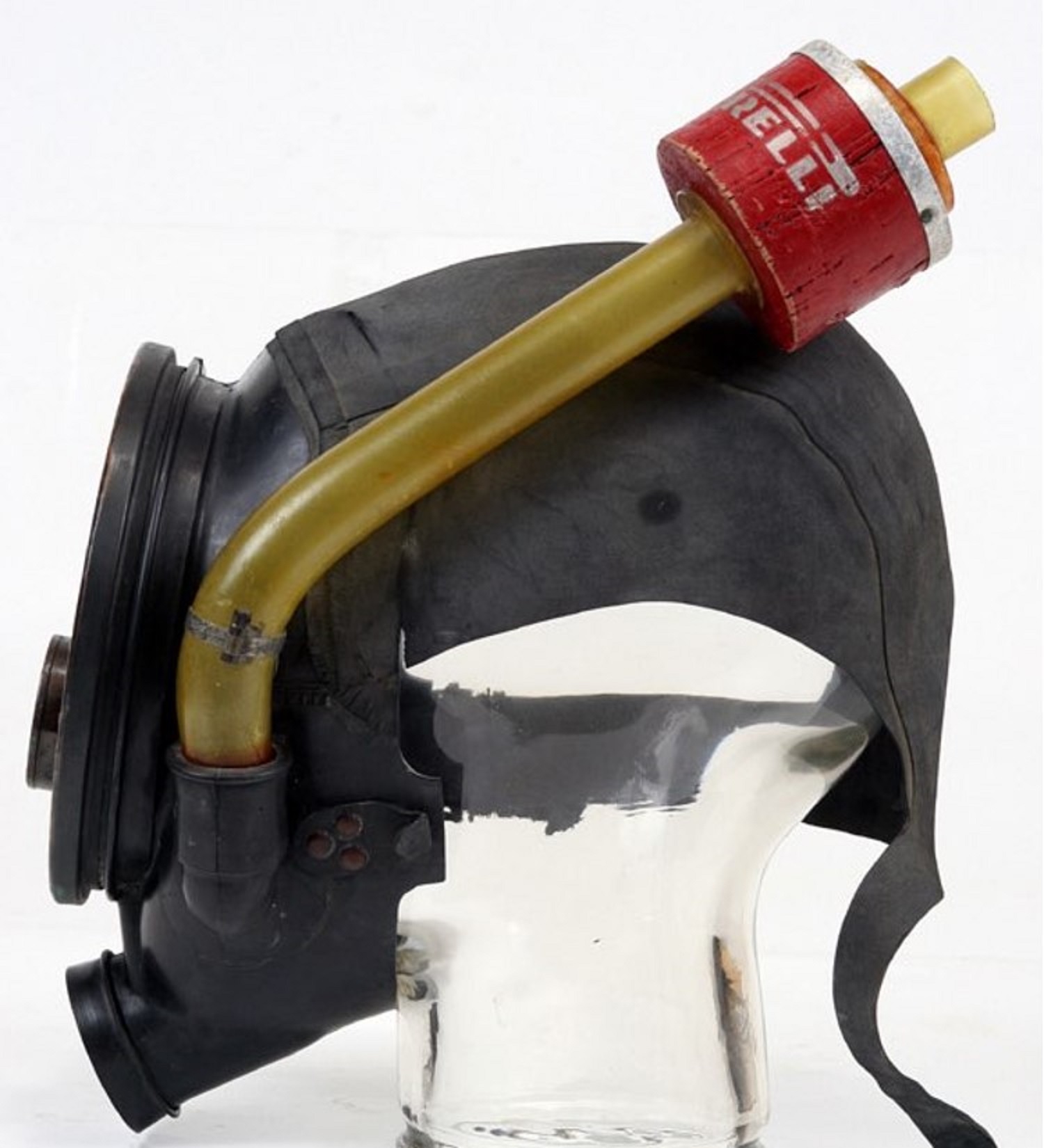 |
| Figure 23 |
Figure 24 |
The other clear indication that can be obtained from the photos shown before was that the snorkel tube in these first versions of the mask was made of transparent plastic rather than blue plastic, as in the most recent sample in my possession and clearly shown in the Pirelli catalogues.
If I wanted to obtain a pad floating valve as similar as possible to the original one, I would have had finding a solutions different than 3D printing. I searched for long time on the net for cork rough material having the right dimensions to obtain the pad floating valve but the only reasonable solution I found was to use two large wine barrel cork caps which I glued together in order to have the starting dimensions compatible with those of the "Nereide" pad floating valve. (see Figure 25). At this point it was a matter of finding a carpenter capable of working the piece of cork with a wood lathe so obtaining a floating pad having the same shape and dimensions as the original ones. The result of this work is shown in Figure 26.
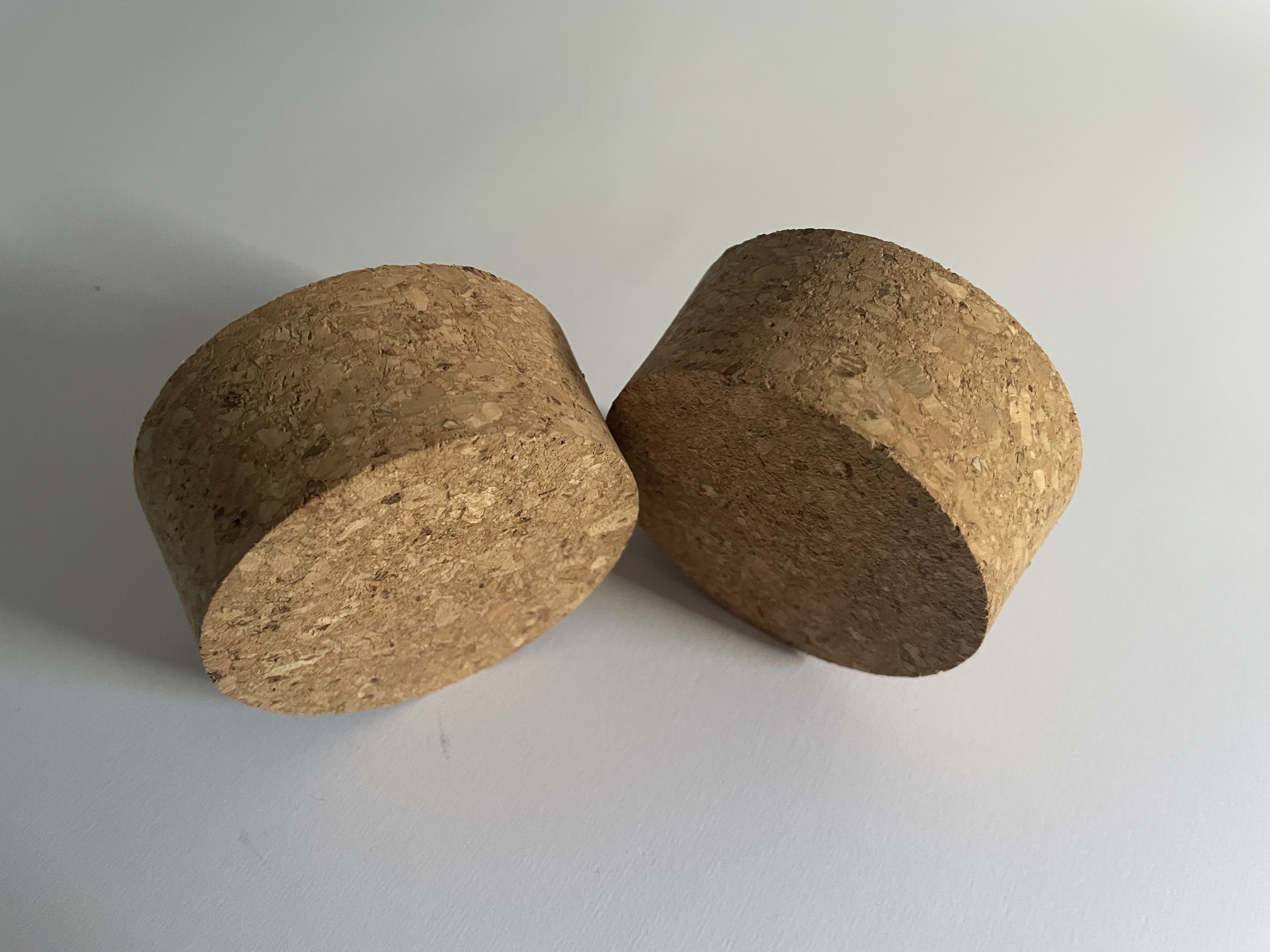 |
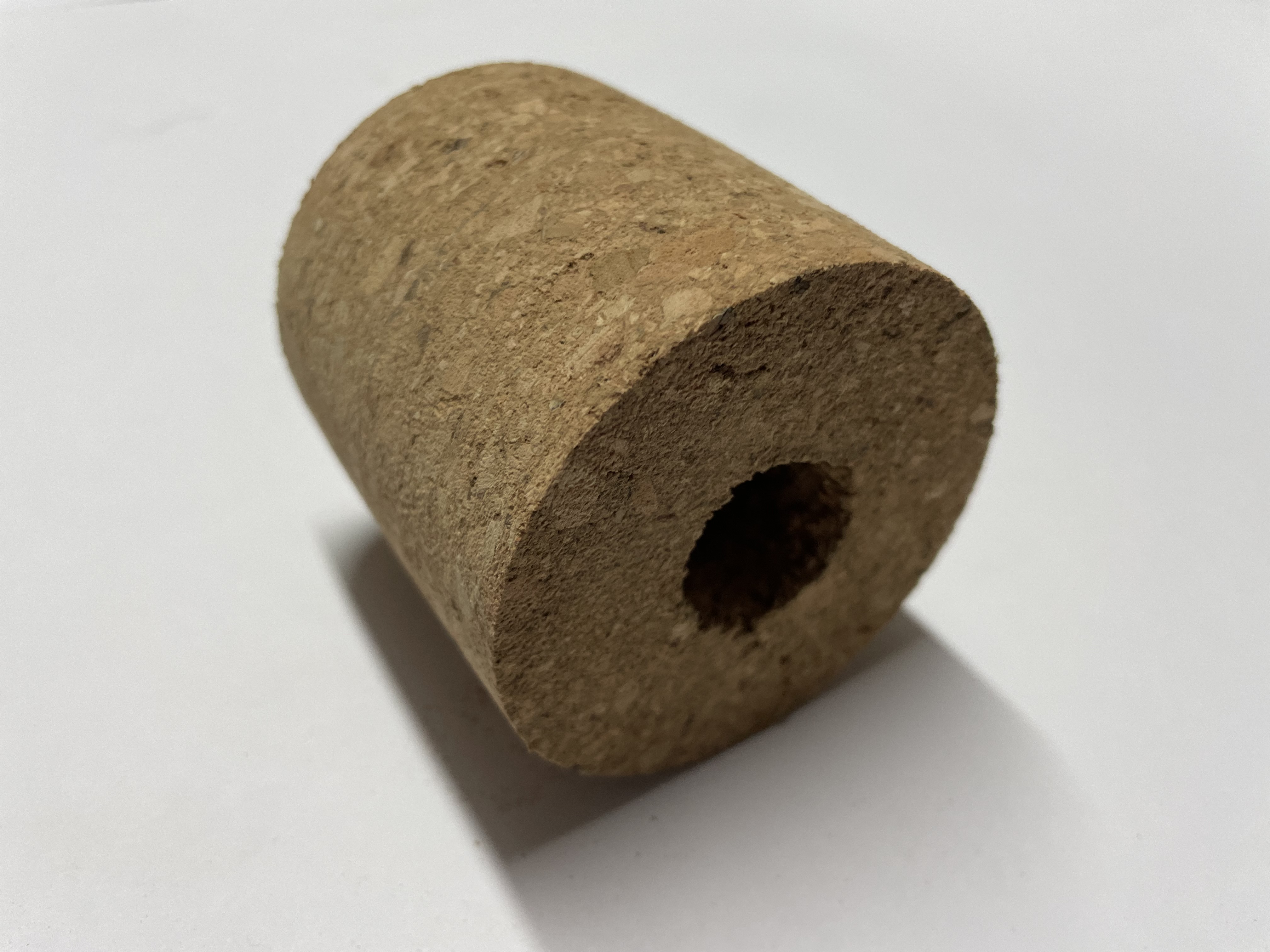 |
| Figure 25 |
Figure 26 |
Not being able to find the aluminum ring of the right size for the upper part of the cork floating pad, this component was first 3D designed using CAD and then manufactured in plastic material by a 3D printer (see Figure 27 and Figure 28).
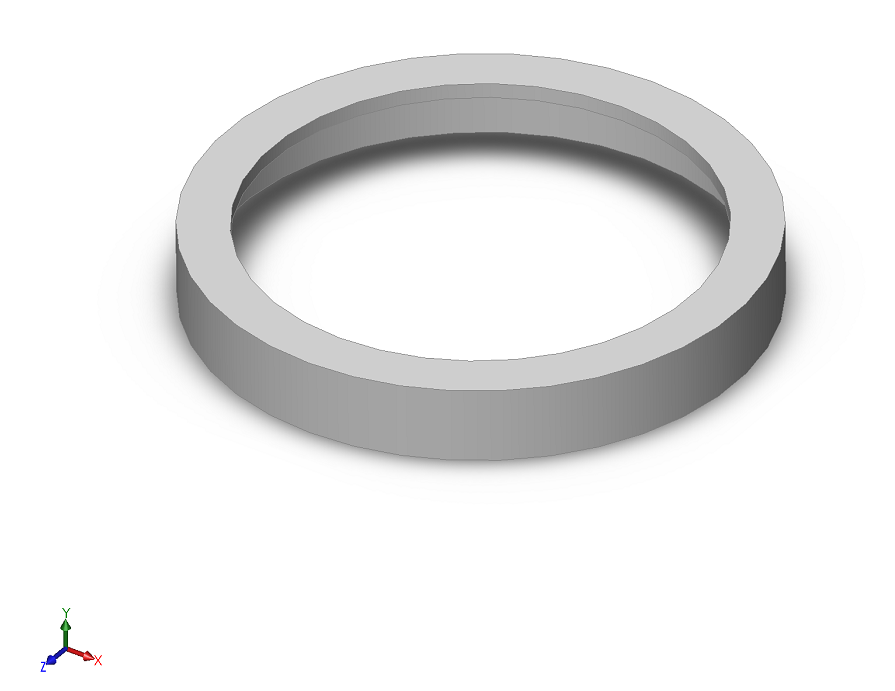 |
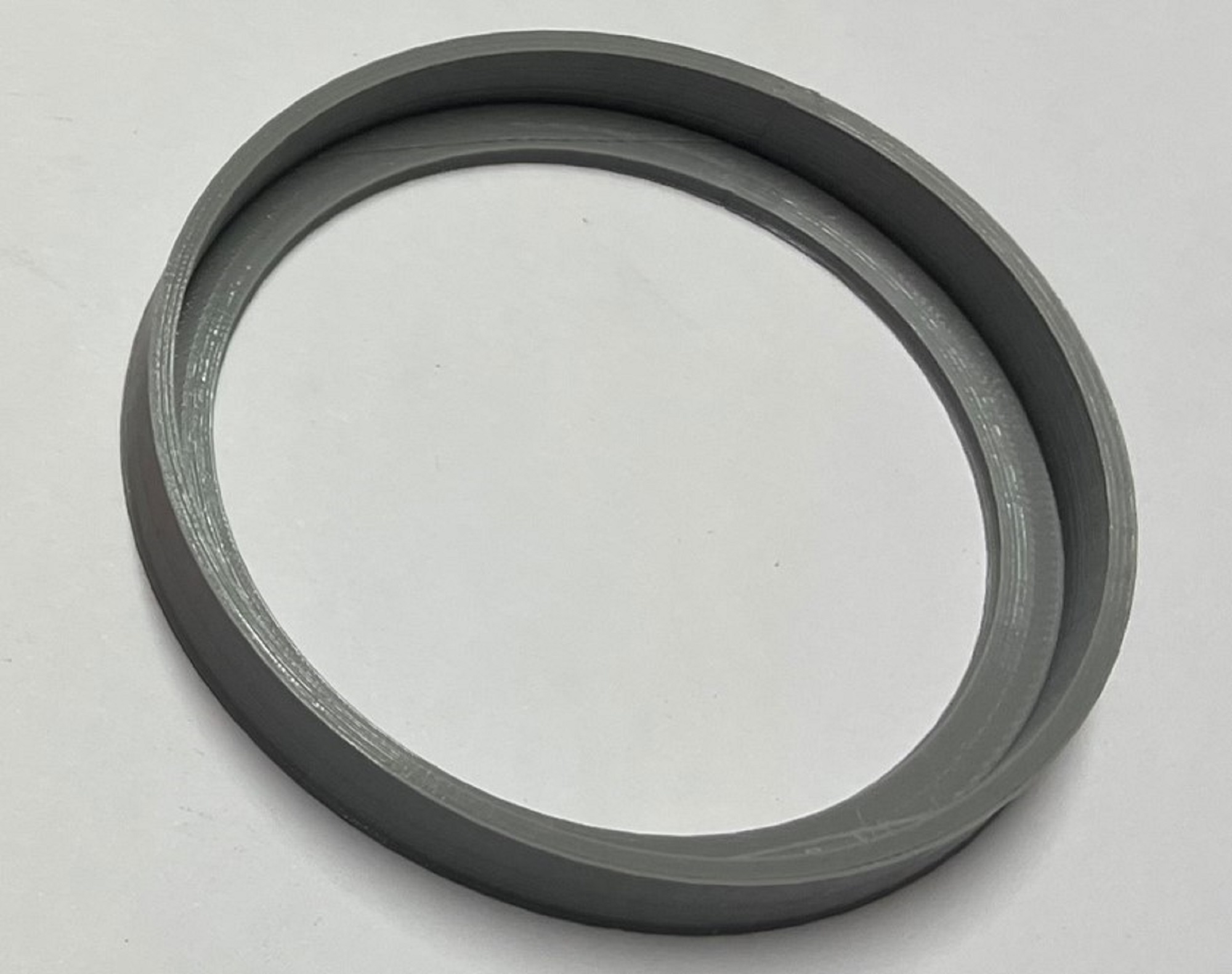 |
| Figure 27 |
Figure 28 |
In order to create the silver painted "Pirelli" brand on the red background of the cork floating pad, I slightly modified the “Pirelli” brand file, found online, in order to obtain a die for painting the writing. The modified brand was then printed on adhesive film (see Figure 29), in the dimensions obtained from the analysis of photos of the original floating pad. The film surface was finally handled with a small cutter so obtaining the final die cut (see Figure 30).
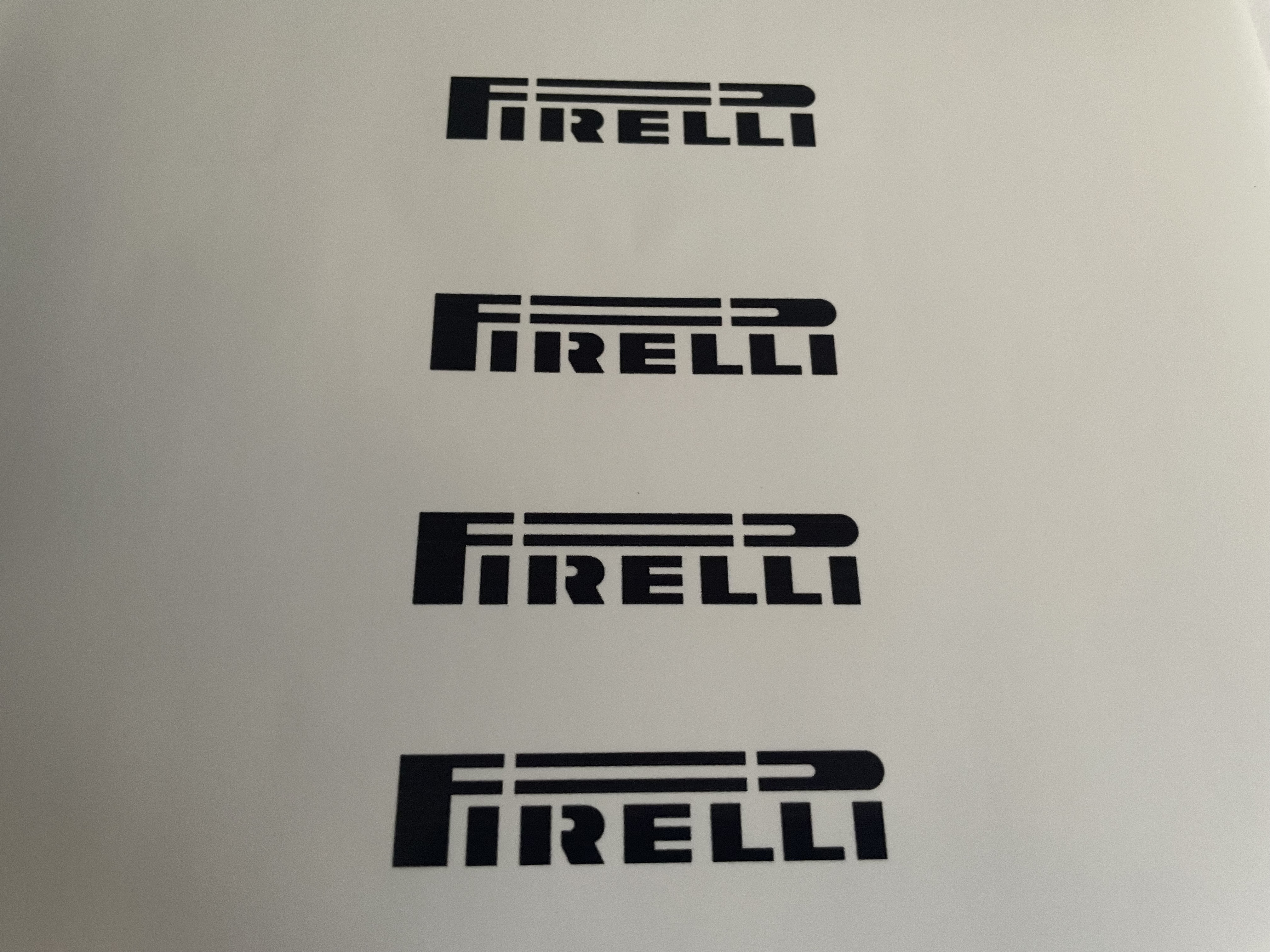 |
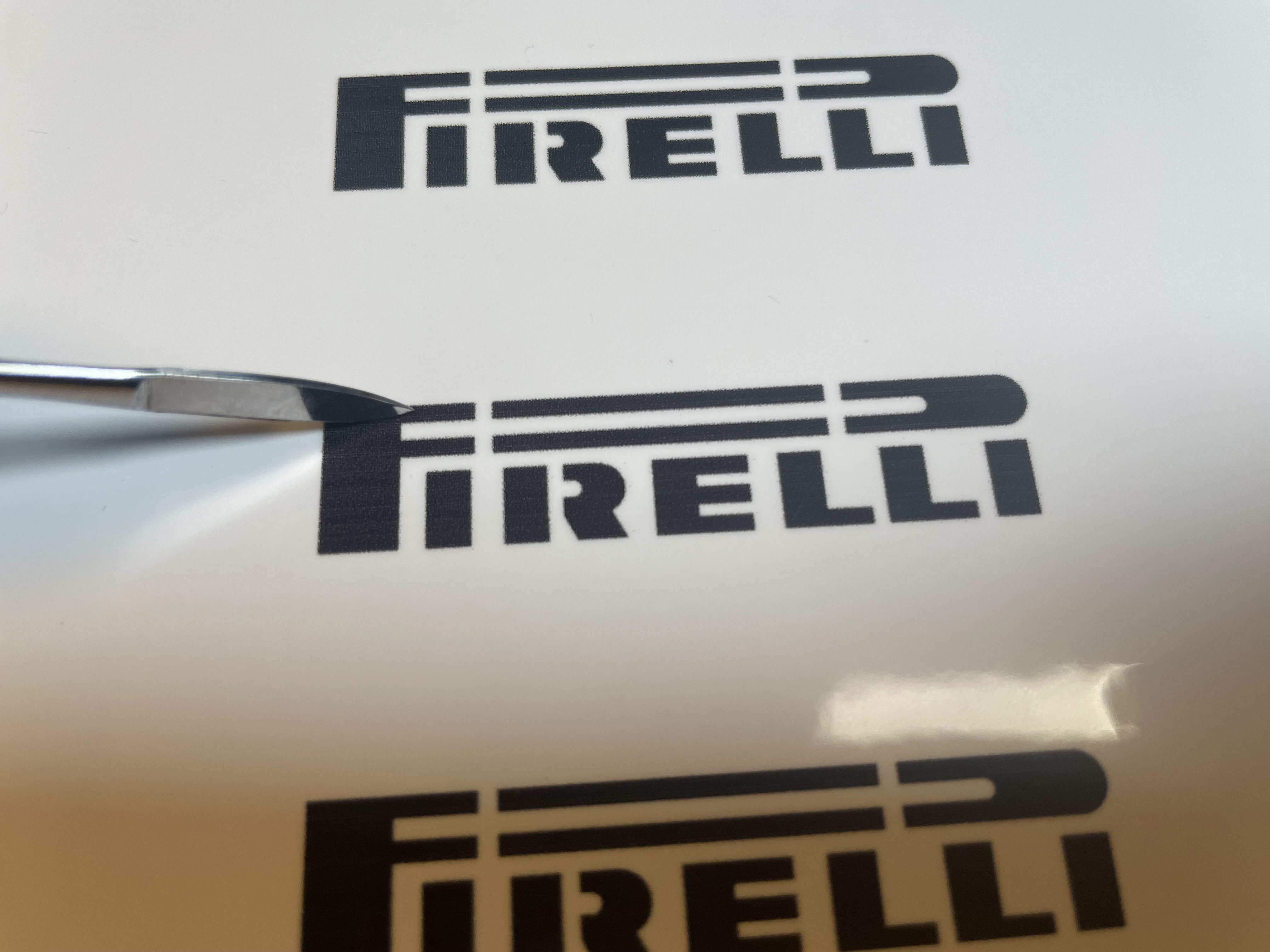 |
| Figure 29 |
Figure 30 |
The sealing disc to be mounted on the upper surface of the floating pad was simply obtained from a 1 mm thick silicone rubber sheet, provided with an adhesive surface. This sheet was cut and shaped into the right dimensions.
Now I was able to paint, using normal spray cans, the body of the floating pad in red first and then the "Pirelli" writing and the upper ring in silver (see Figure 31 and Figure 32).
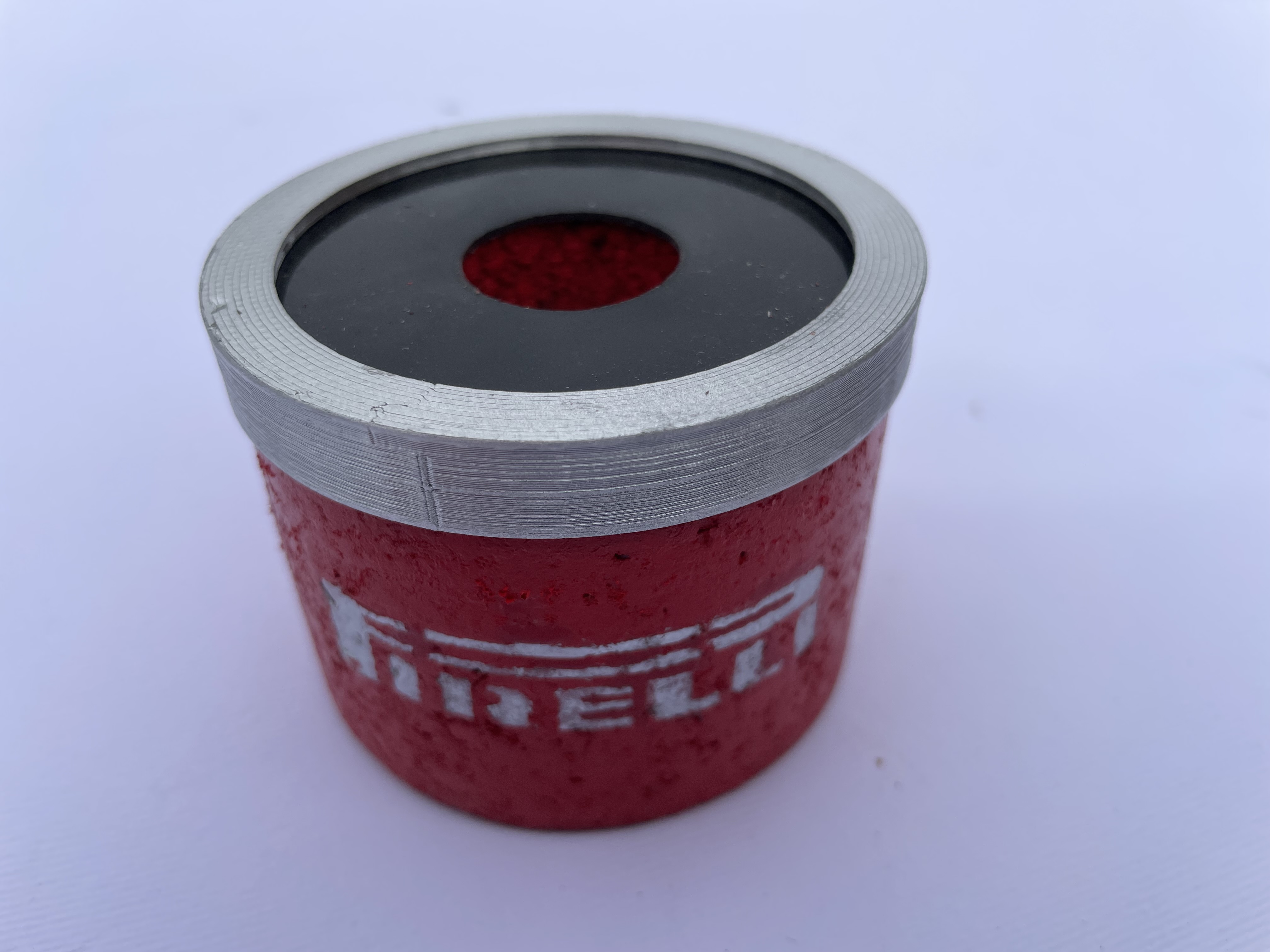 |
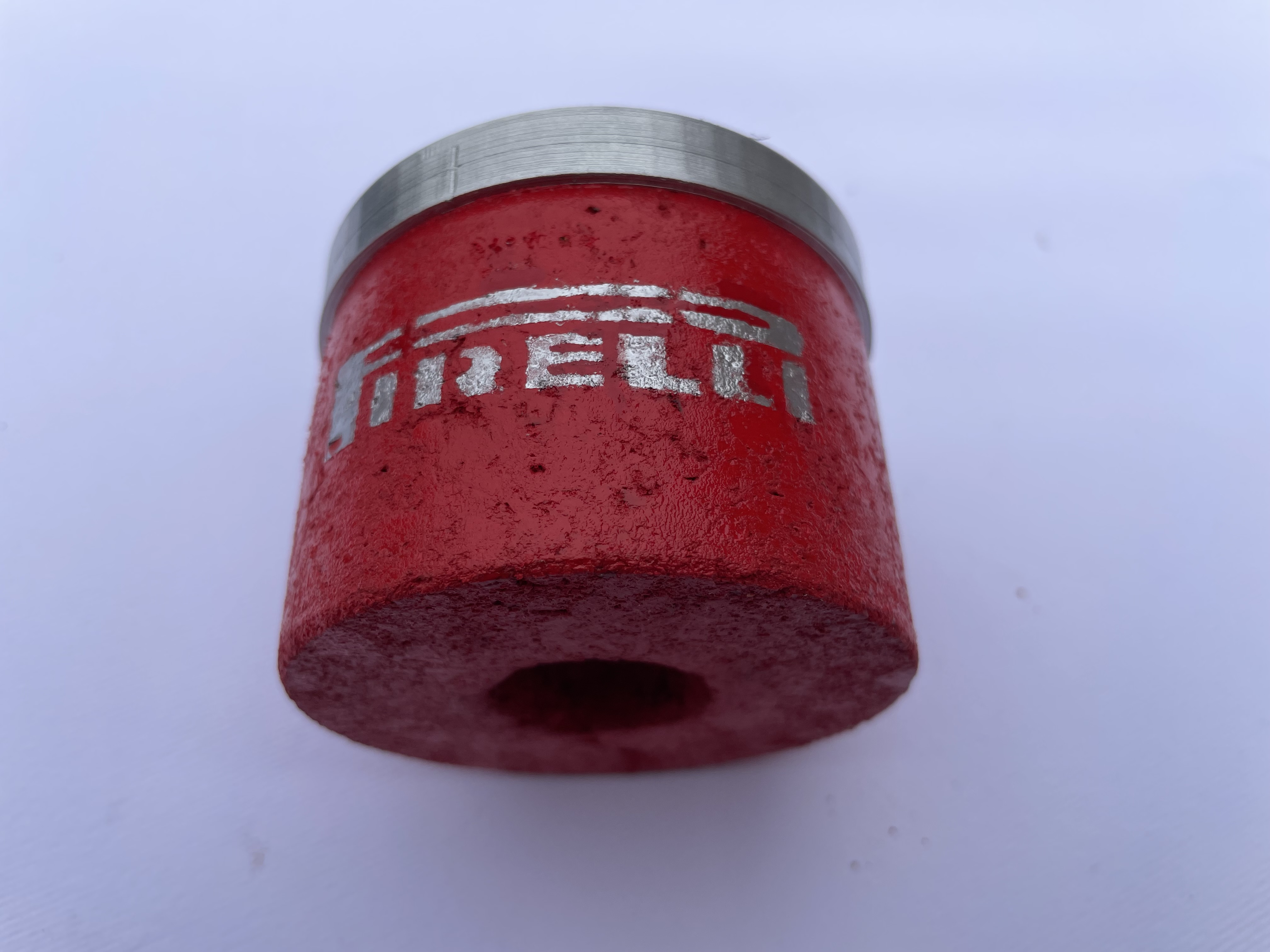 |
| Figure 31 |
Figure 32 |
The rigid transparent plastic (polycarbonate) tube was found on eBay. The closest available diameter found was 22 mm instead of 23 mm. In order to connect the upper part of the snorkel, provided with its pad floating valve, with its bent lower part engaged with the mask body, I selected a transparent polycarbonate tube with an external diameter equal to the internal diameter of the main snorkel tube (18 mm). A piece of this tube would have been used to connect the two parts of the snorkel by gluing them, after having positioned the red plastic washer working as the lower stop of the cork floating pad. The complete snorkel top assembly, including the cork floating pad and the fixed plastic red tip, is shown in Figure 33 and Figure 34.
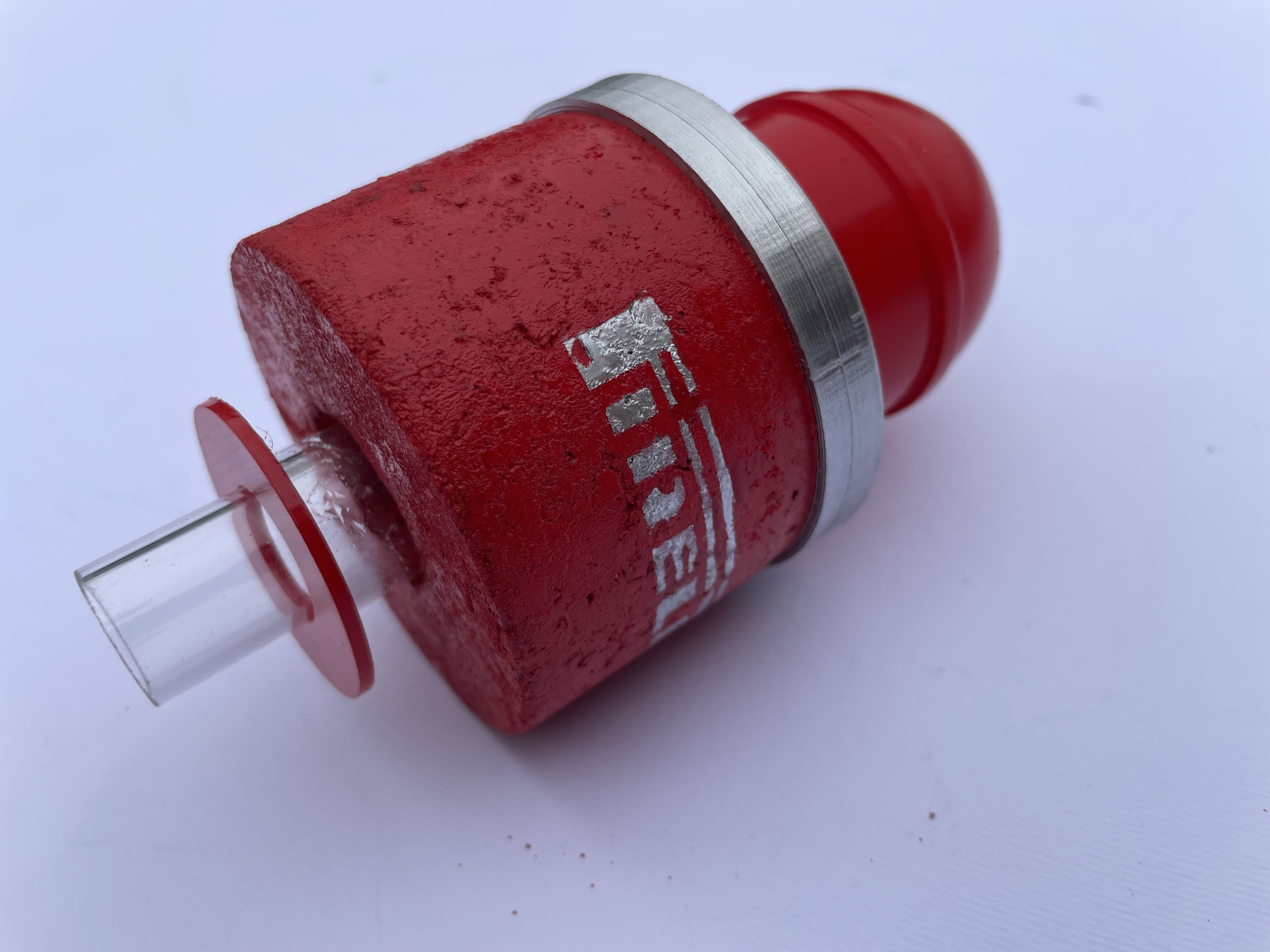 |
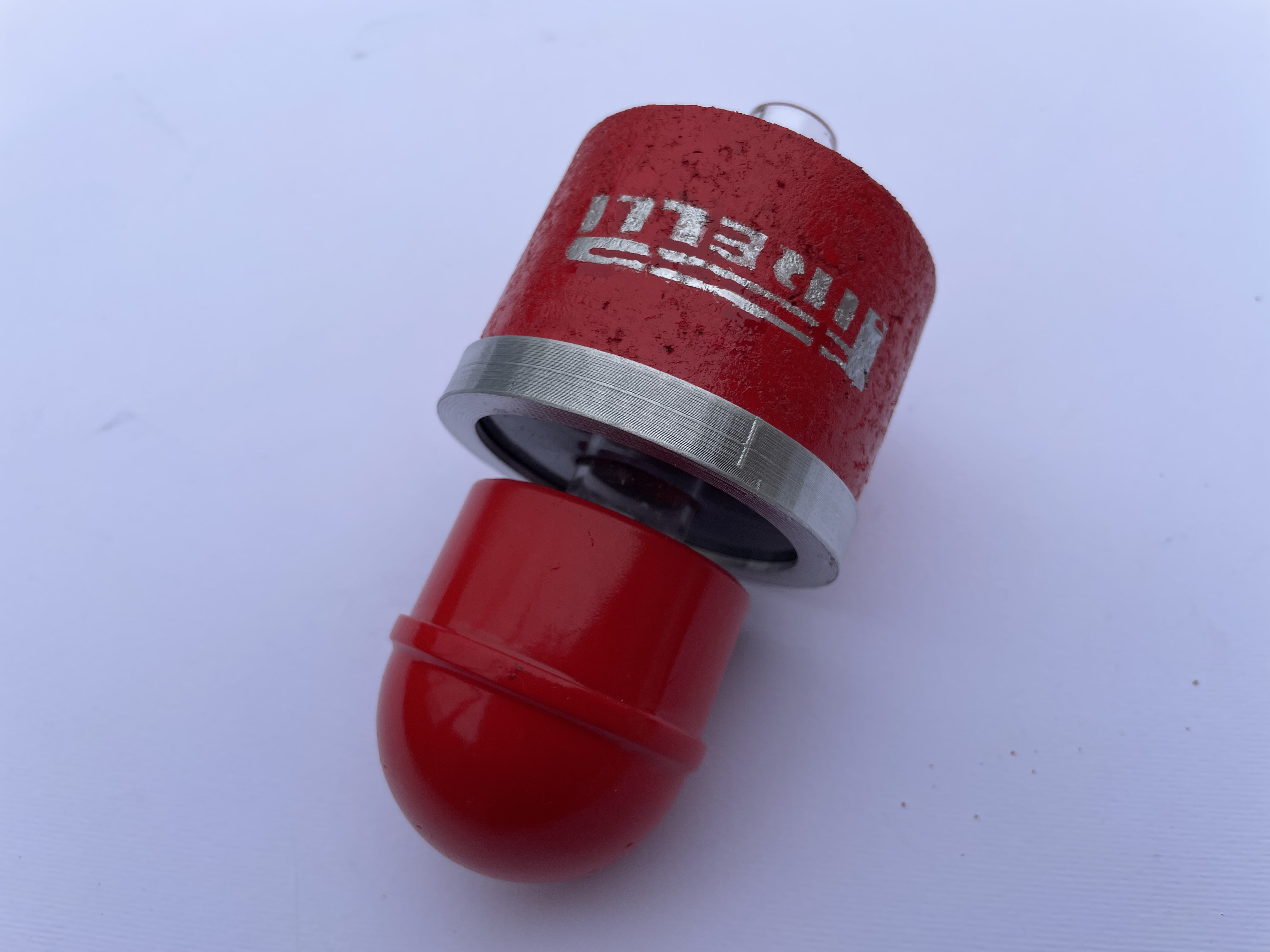 |
| Figure 33 |
Figure 34 |
The problem that remained to be solved was that of making the bent in the transparent tube equal to that of the original snorkel without breaking it and possibly without deforming its circular section in correspondence of the bent. Having never carried out this operation and being quite worried about the outcome of the tube bending procedure, I searched online for some useful information about similar processes. At the end I discovered that transparent acrylic tubes are normally used (although in smaller diameters) in automatic beverage distribution machines (coffee, cappuccino, tea, chocolate, etc.). In fact, the transparency of the pipe is required to verify the degree of cleanliness and possible calcification of the pipe itself. I also found very explanatory videos on YouTube that showed the correct technique of bending these tubes which are very rigid and easy to damage. The process is carried out by initially heating the area of the tube to be bent using a hot air gun until the material becomes soft and deformable and then bending the tube by hand with the help of an appropriate guide and support matrix. The mandatory component to be used to prevent the tube cross section crushing during bending is a silicone rubber bar having circular section and resistant to high temperatures. This bar must be inserted inside the acrylic tube before starting heating with the hot air gun. To facilitate the insertion of the cord inside the tube to be bent, it must first be wetted with water. The diameter of the silicone rubber bar must be equal to the internal diameter of the pipe you want to bend. The main sequences of the entire operation are shown in Figures 35, 36, 37 and 38.I
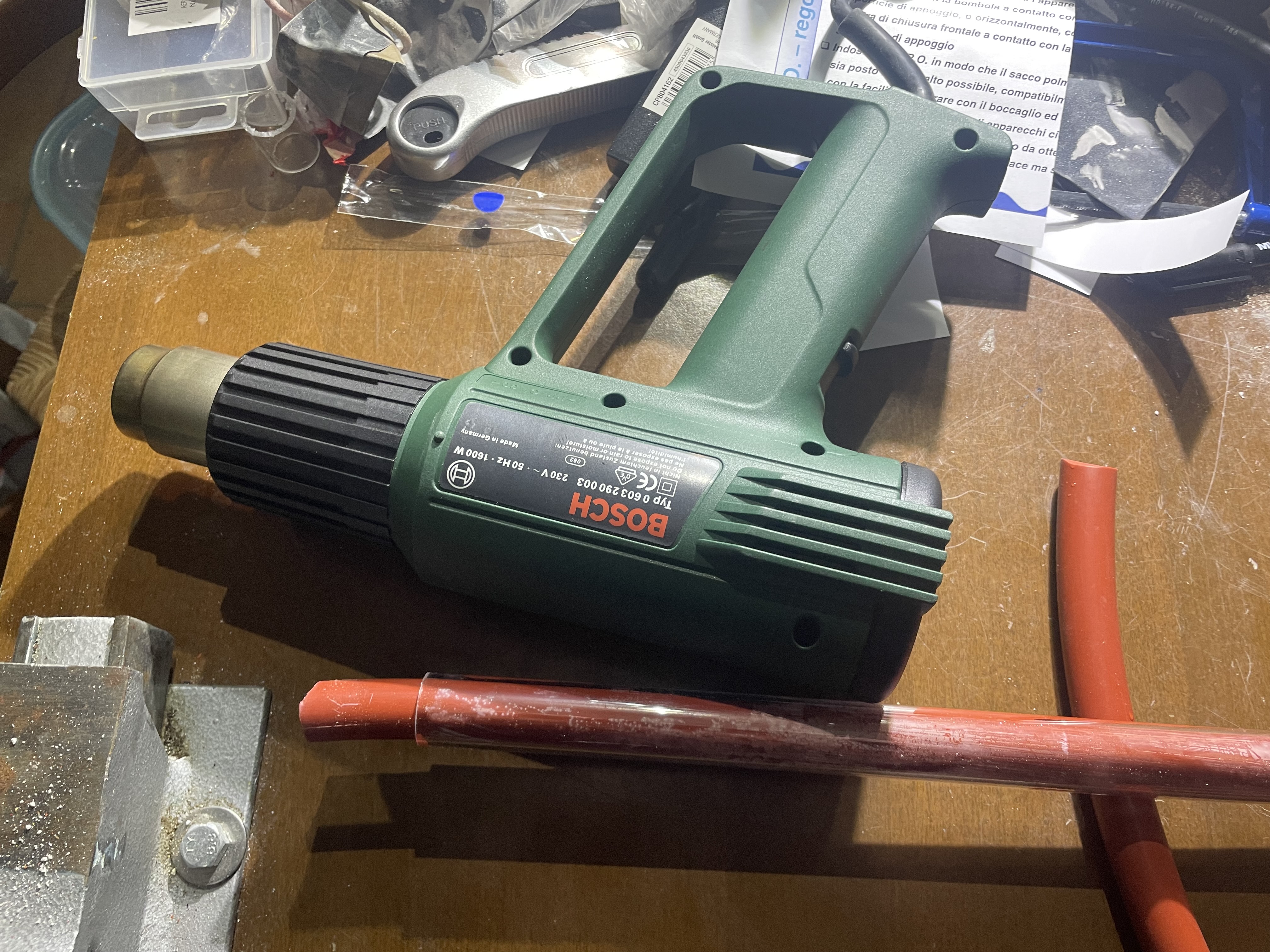 |
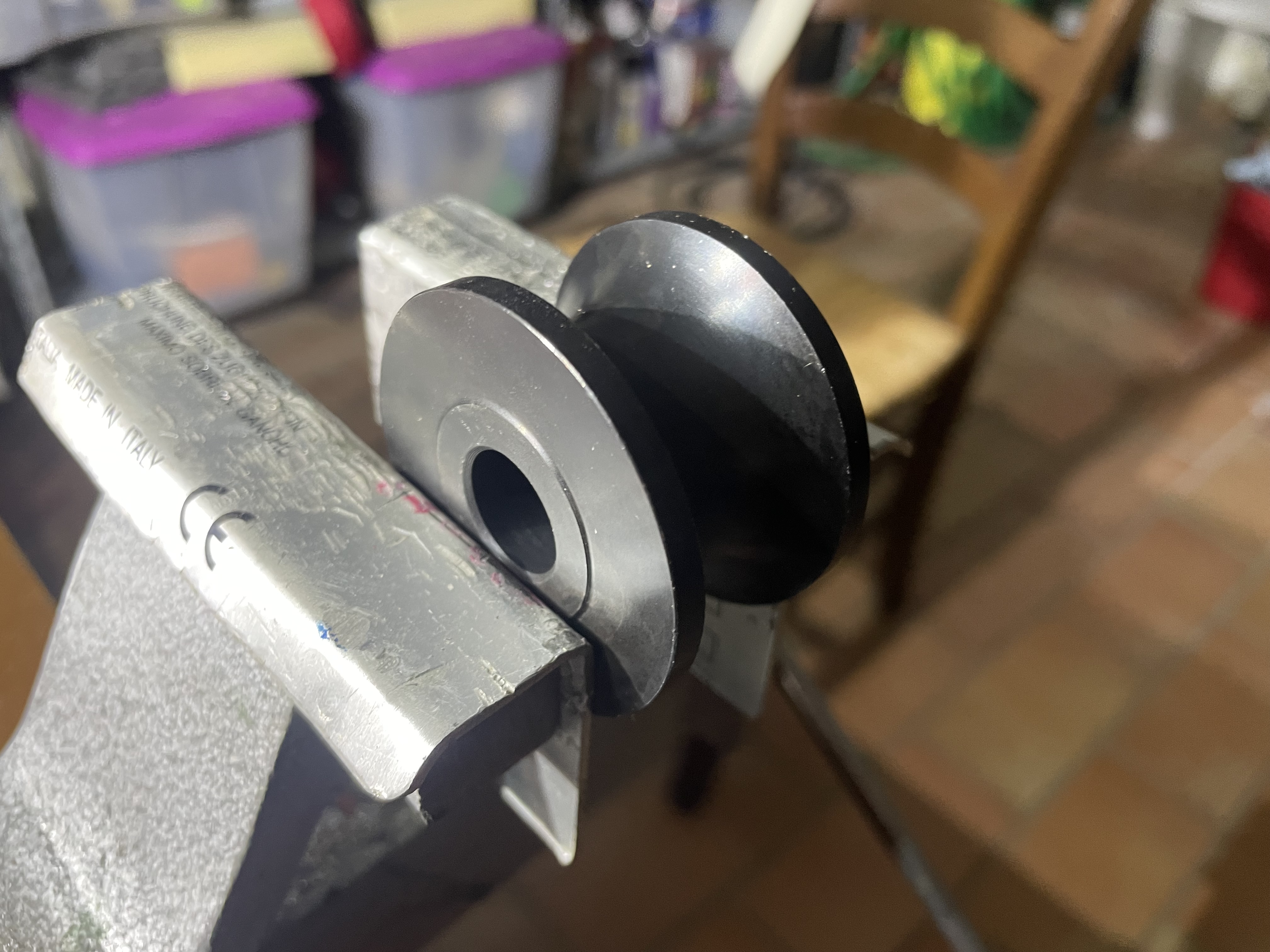 |
| Figure 35 |
Figure 36 |
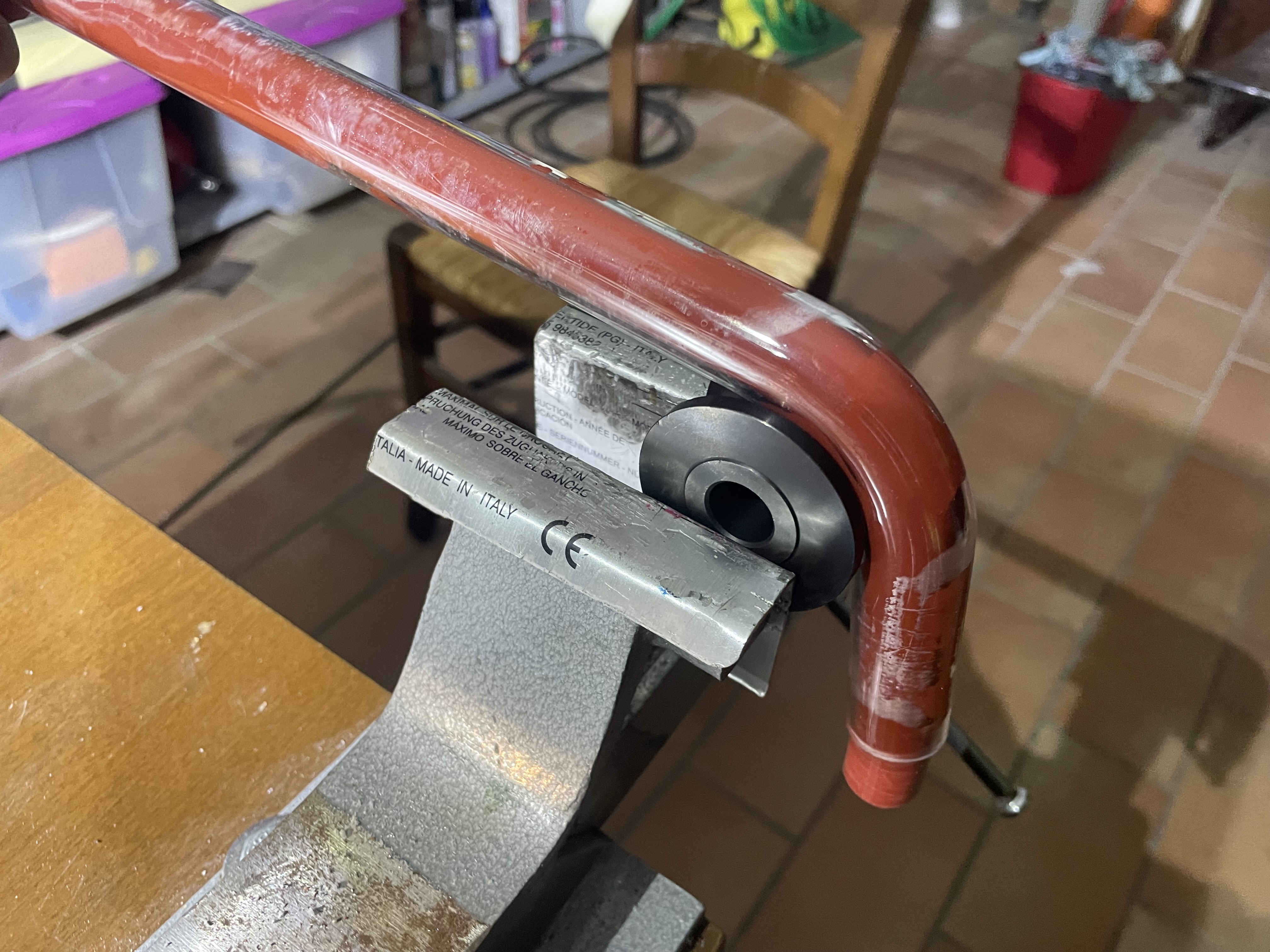 |
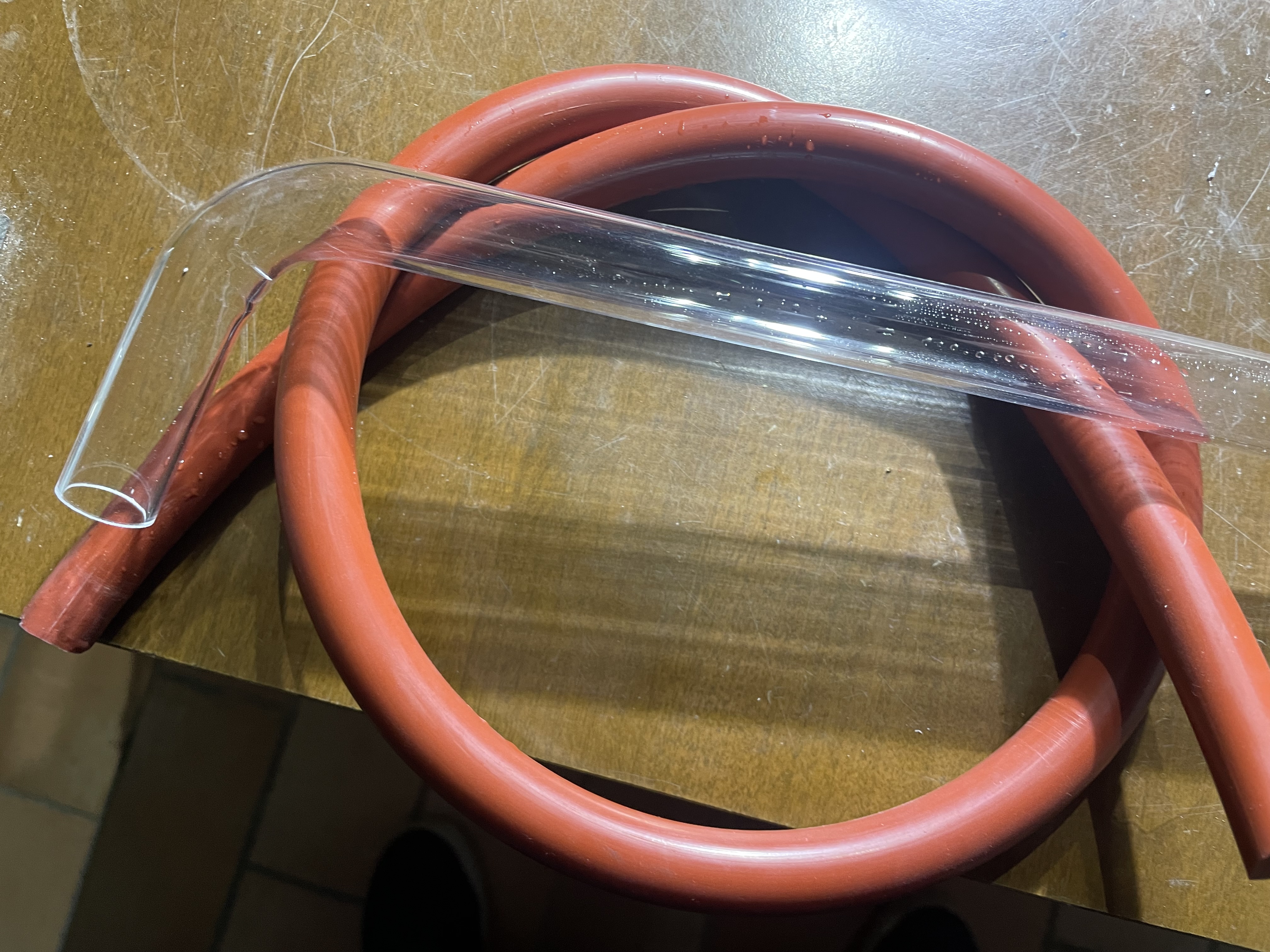 |
| Figure 37 |
Figure 38 |
After bending, the acrylic tube was cut to the right size as measured from the available sample.
Finally, only the final part of the head-strap of the "Nereid first series" mask remained to be rebuilt. This procedure is explained below. Having the intact head-strap of the "Nereide" in blue rubber, it was possible to trace the profile of the missing part on a sheet of black rubber (see Figure 39). The rubber sheet was shaped in such a way to obtain exactly the missing final part. This part was then glued to the remaining part of the black rubber head-strap (see Figure 40).
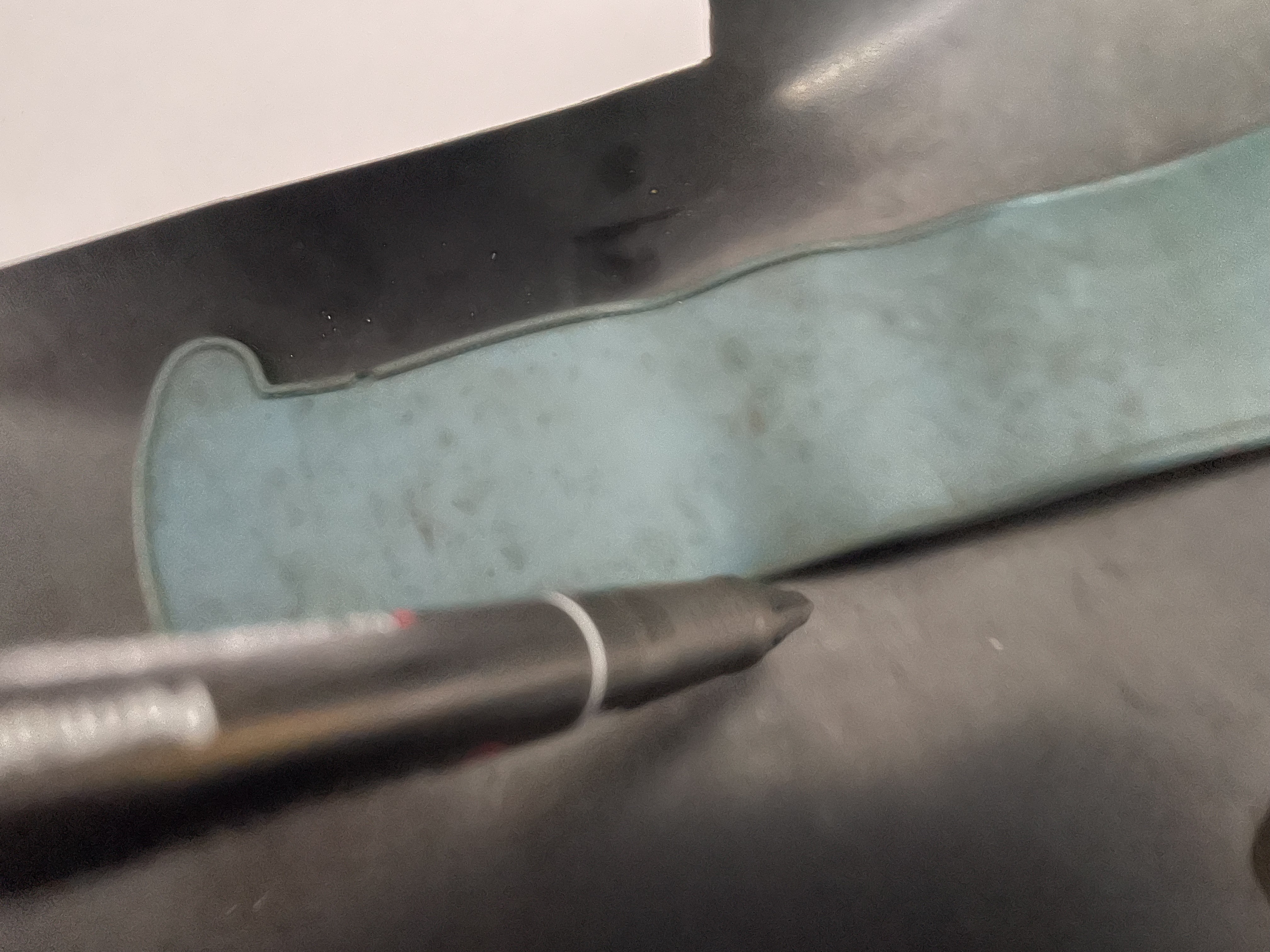 |
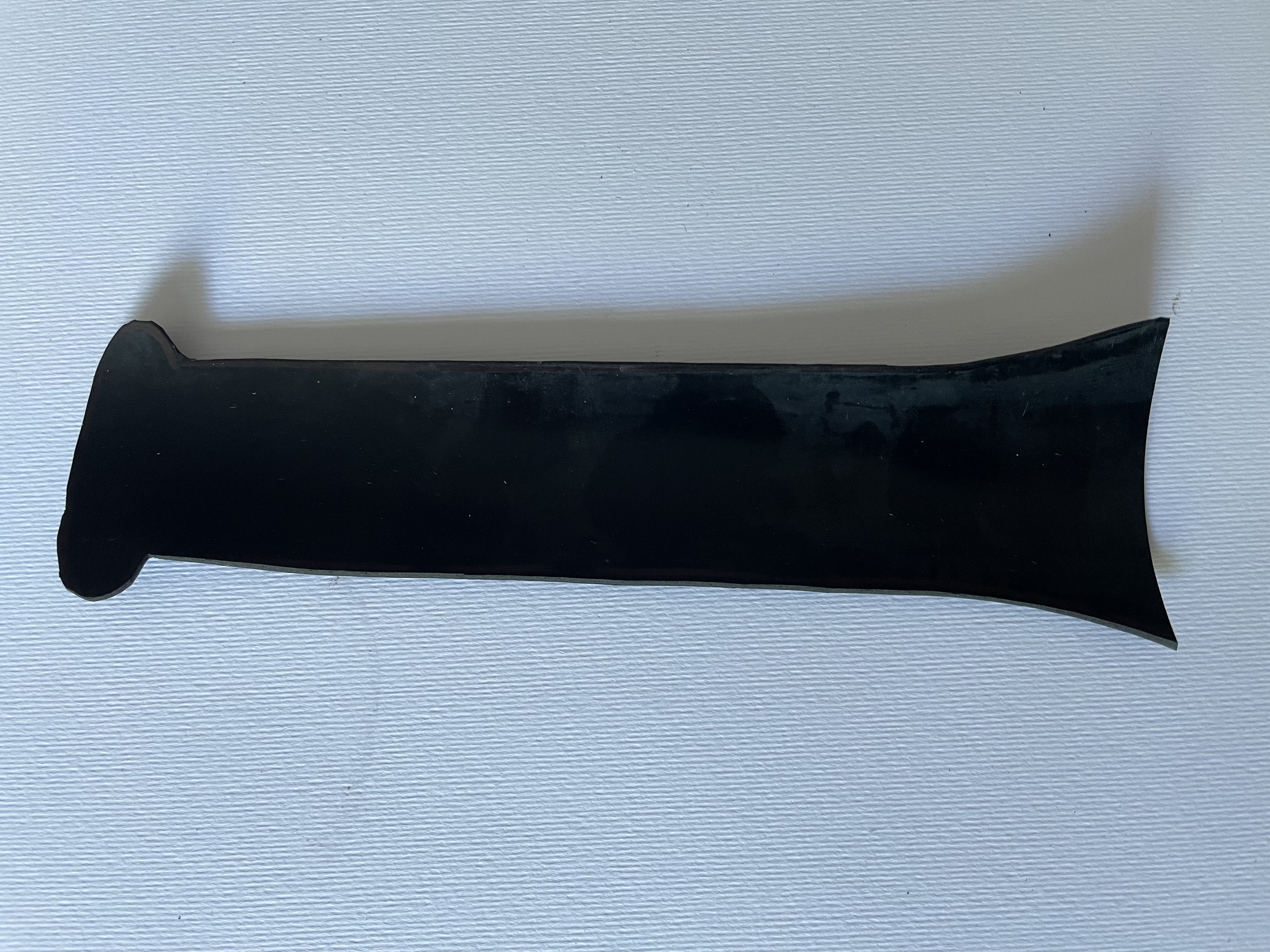 |
| Figure 39 |
Figure 40 |
And finally, after having cleaned the surface of the metal ring connecting the front glass and the body of the mask and having treated it with spray paint capable of producing an effect similar to that of galvanic chrome plating, the whole mask was completely reassembled and the final result is shown in the Figures 41, 42, 43, 44, 45, 46, 47 and 48.
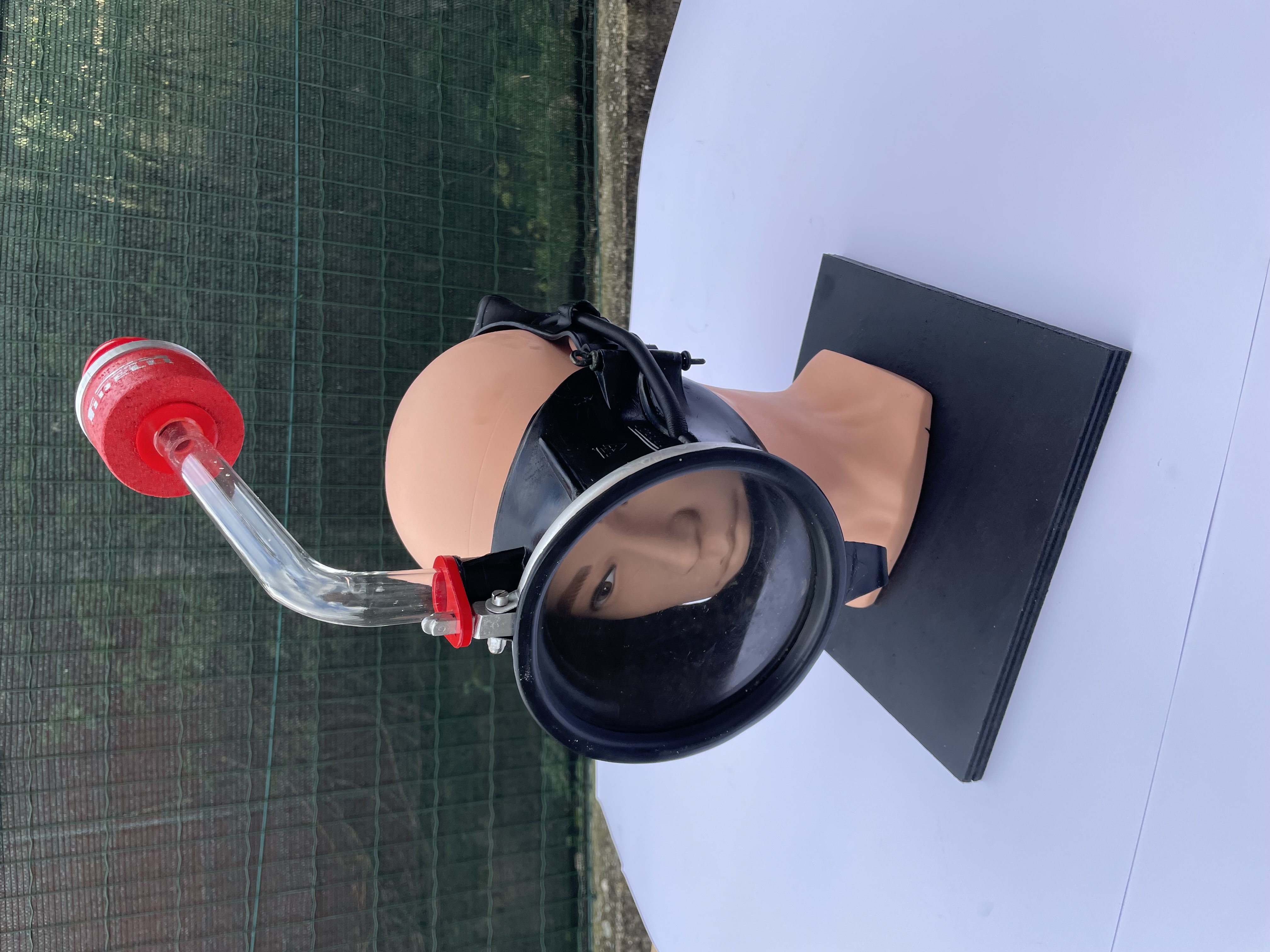 |
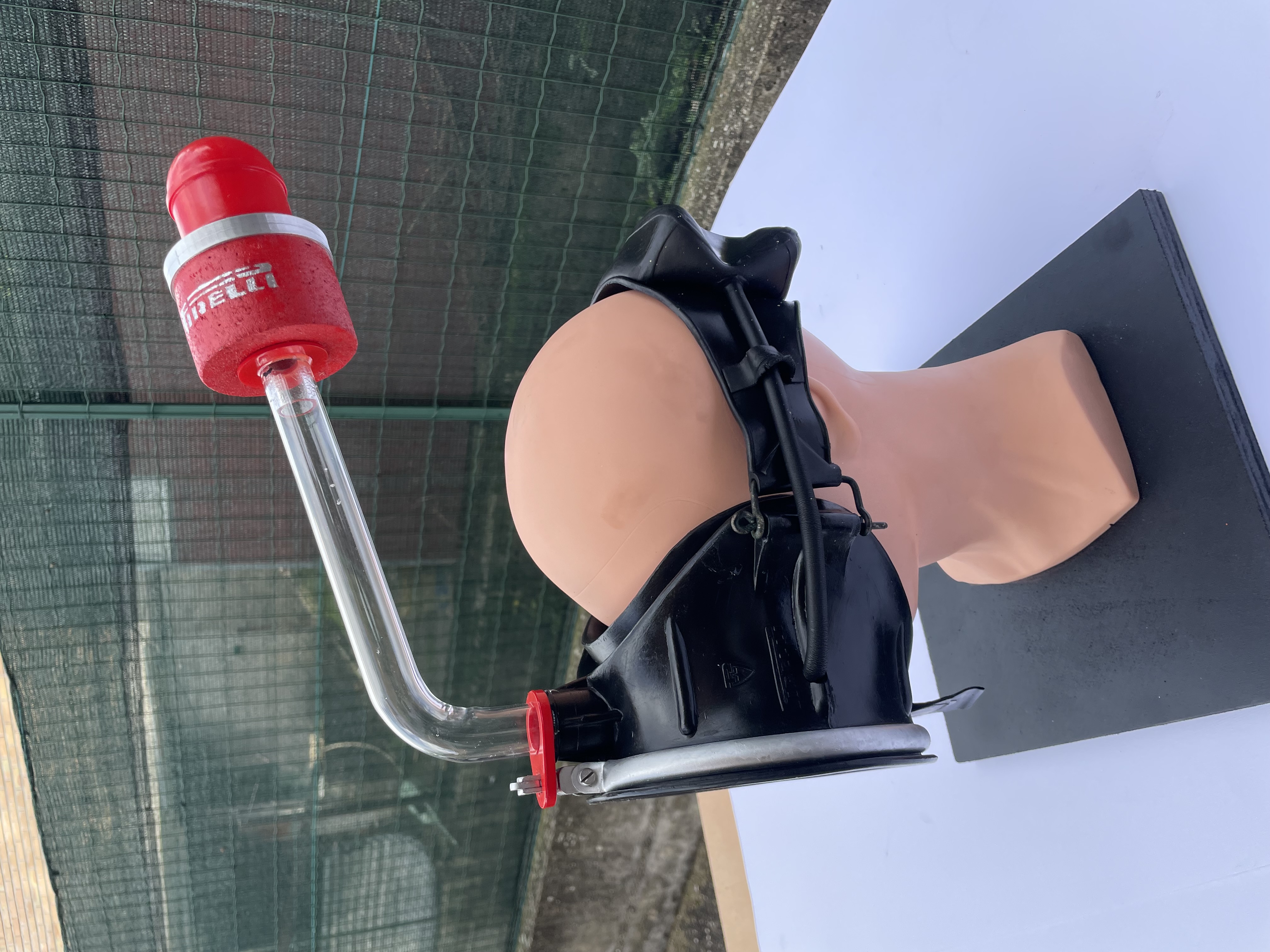 |
| Figure 41 |
Figure 42 |
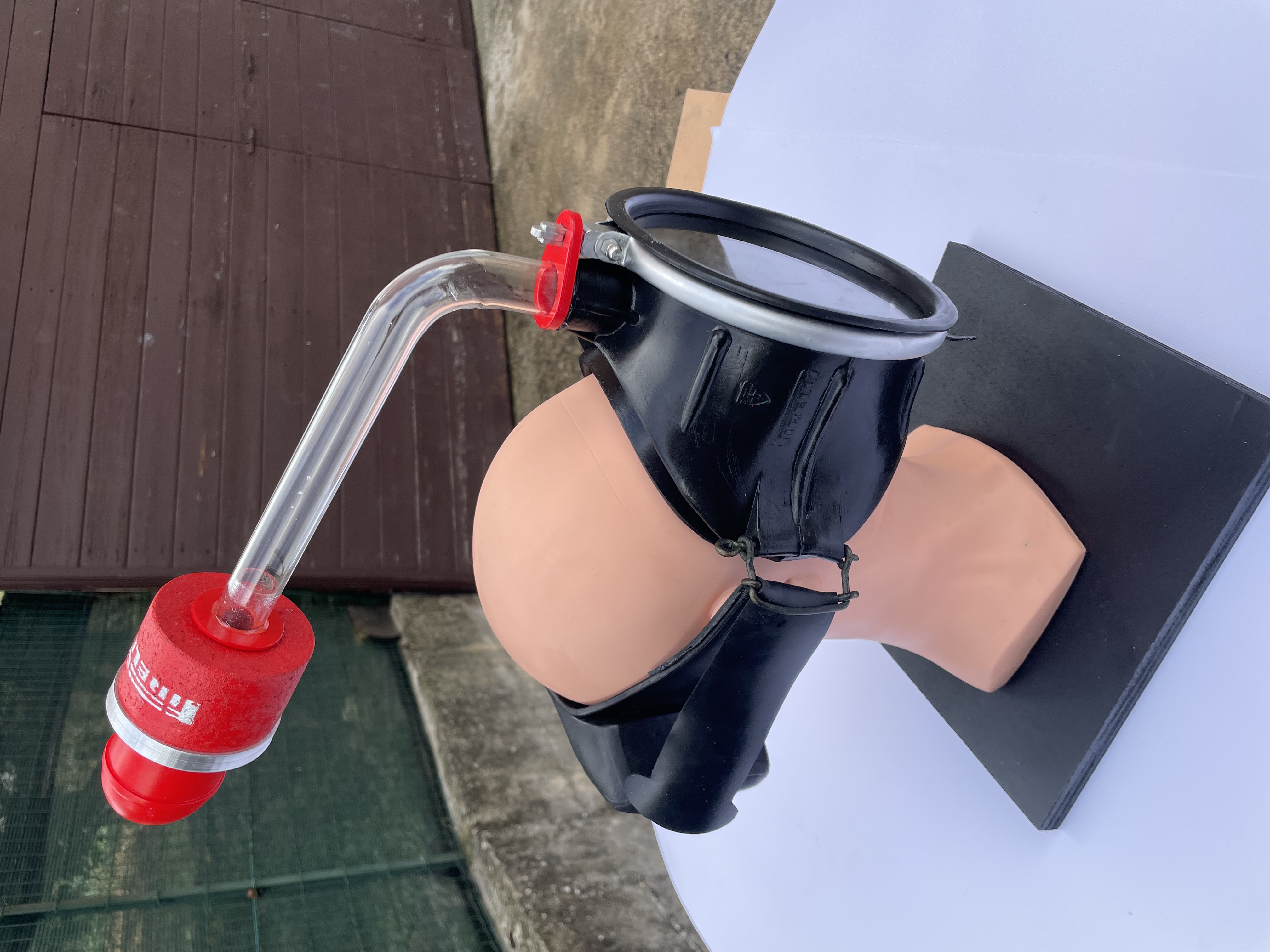 |
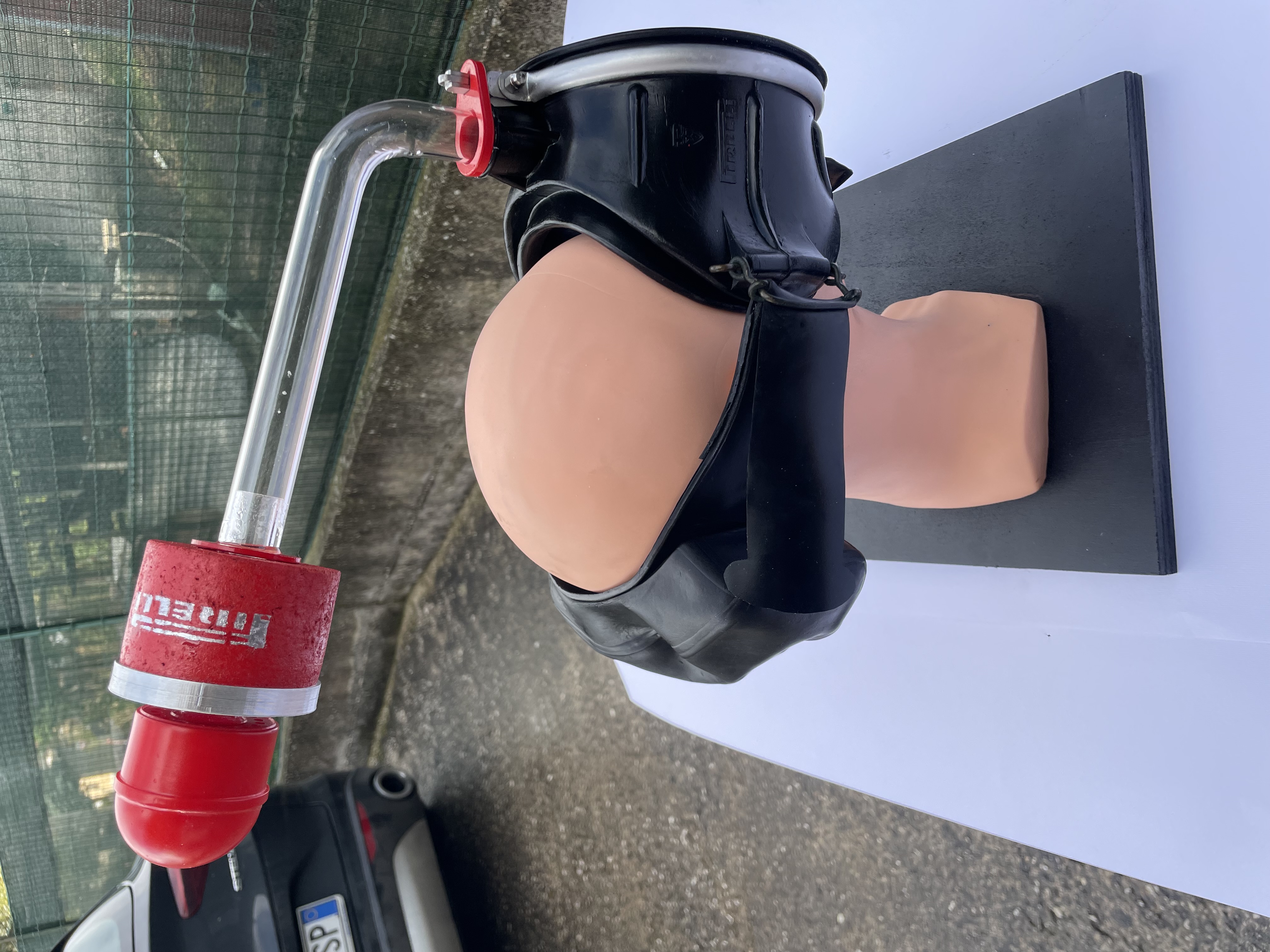 |
| Figure 43 |
Figure 44 |
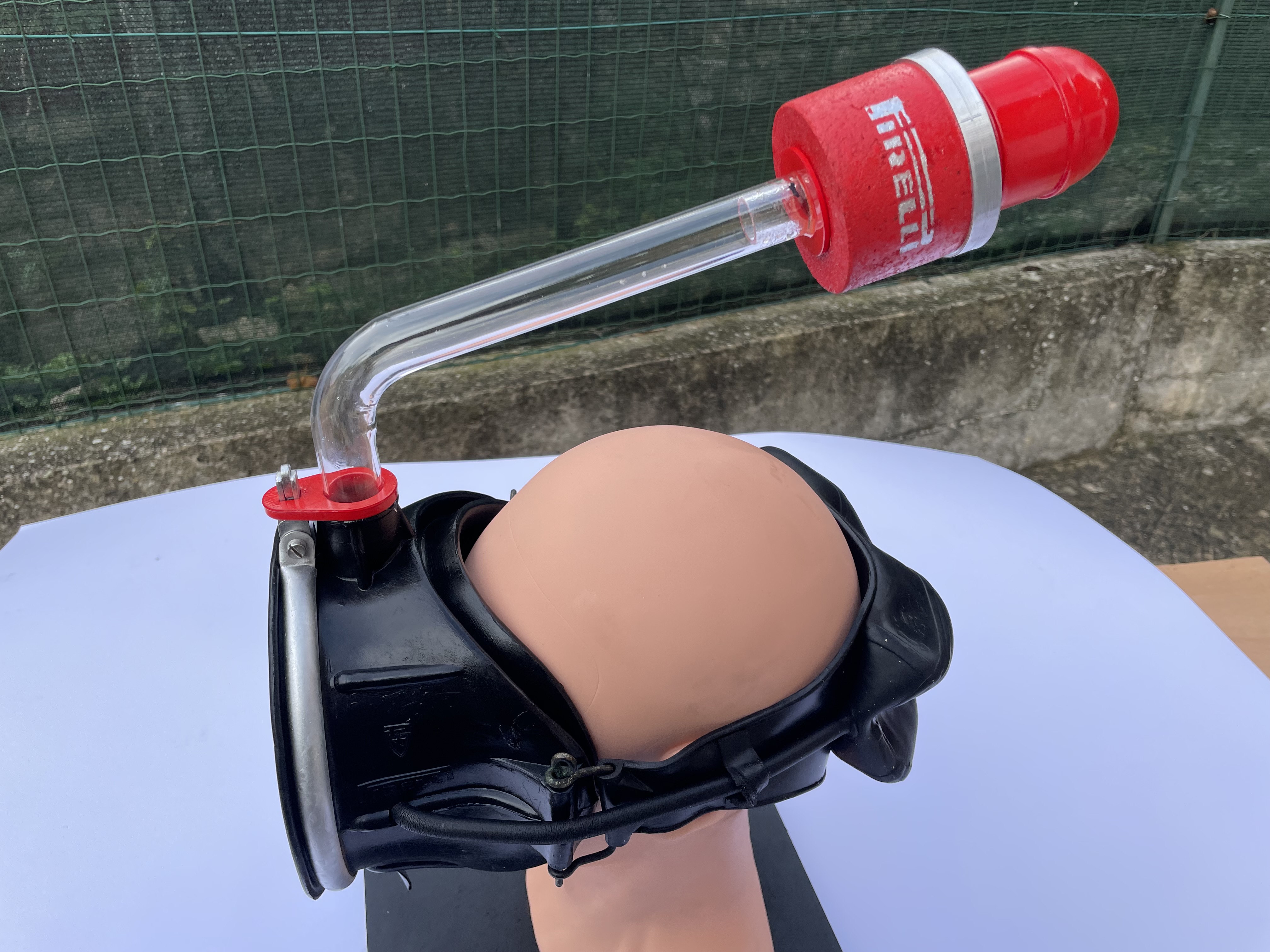 |
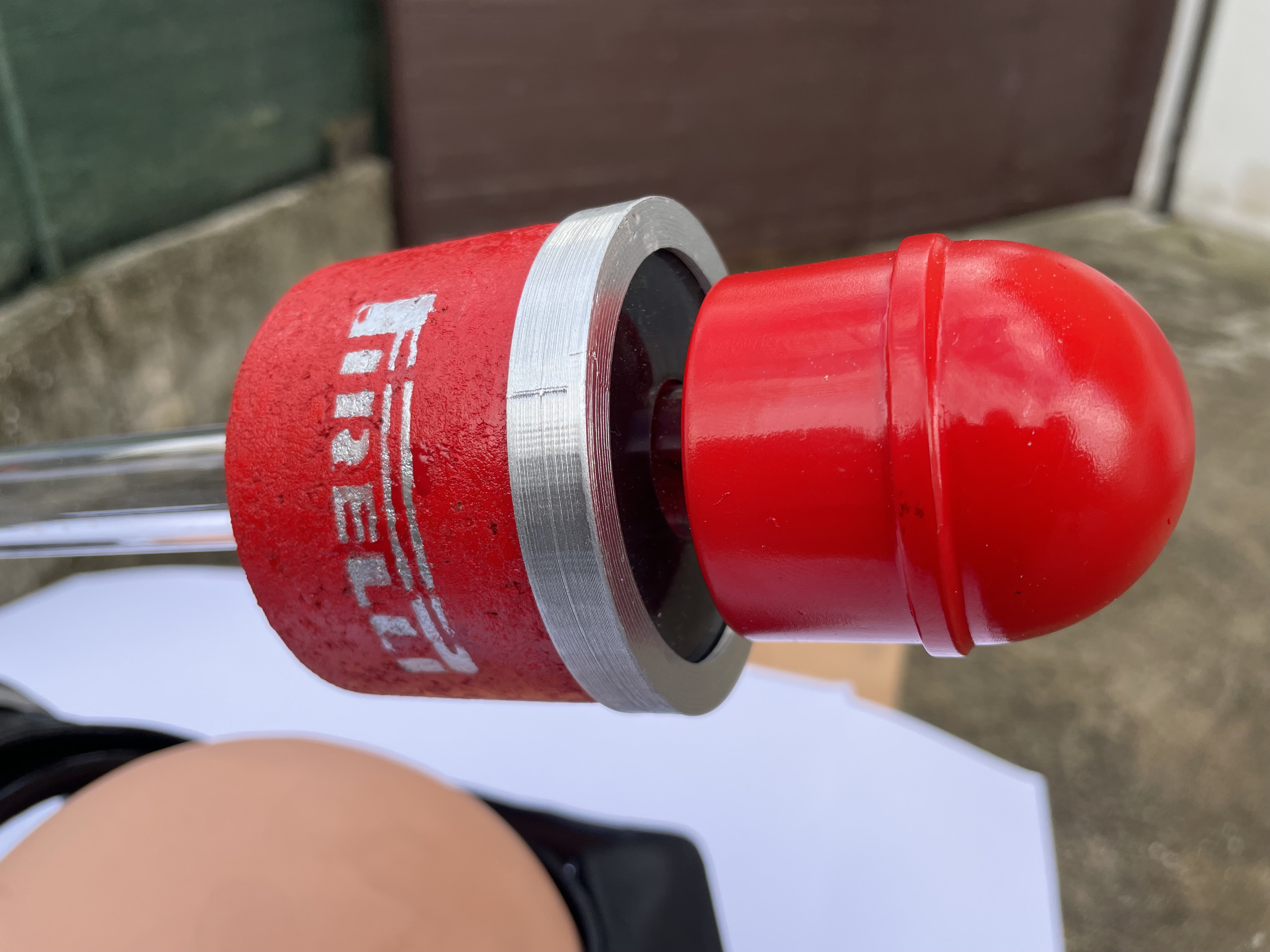 |
| Figure 45 |
Figure 46 |
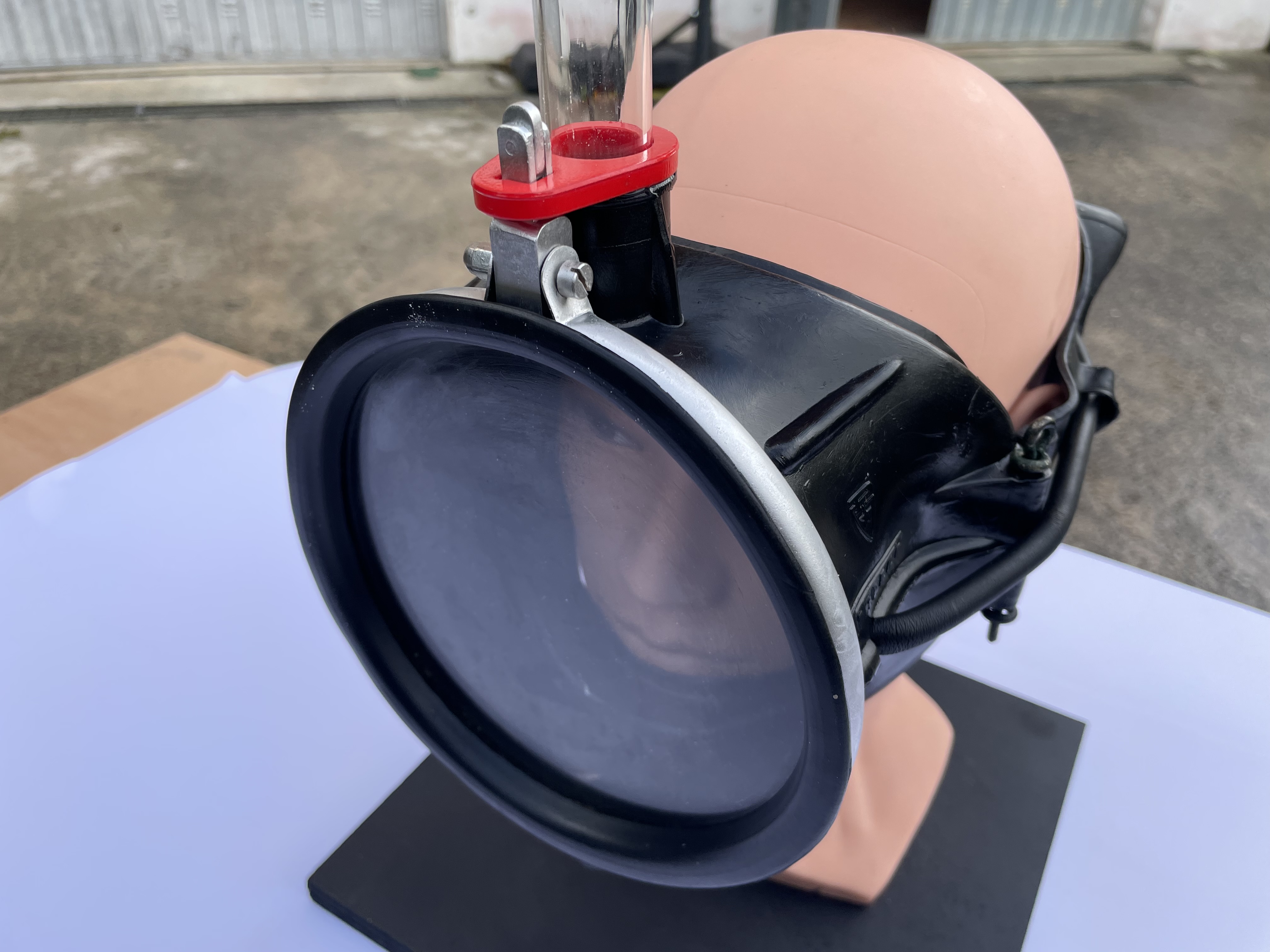 |
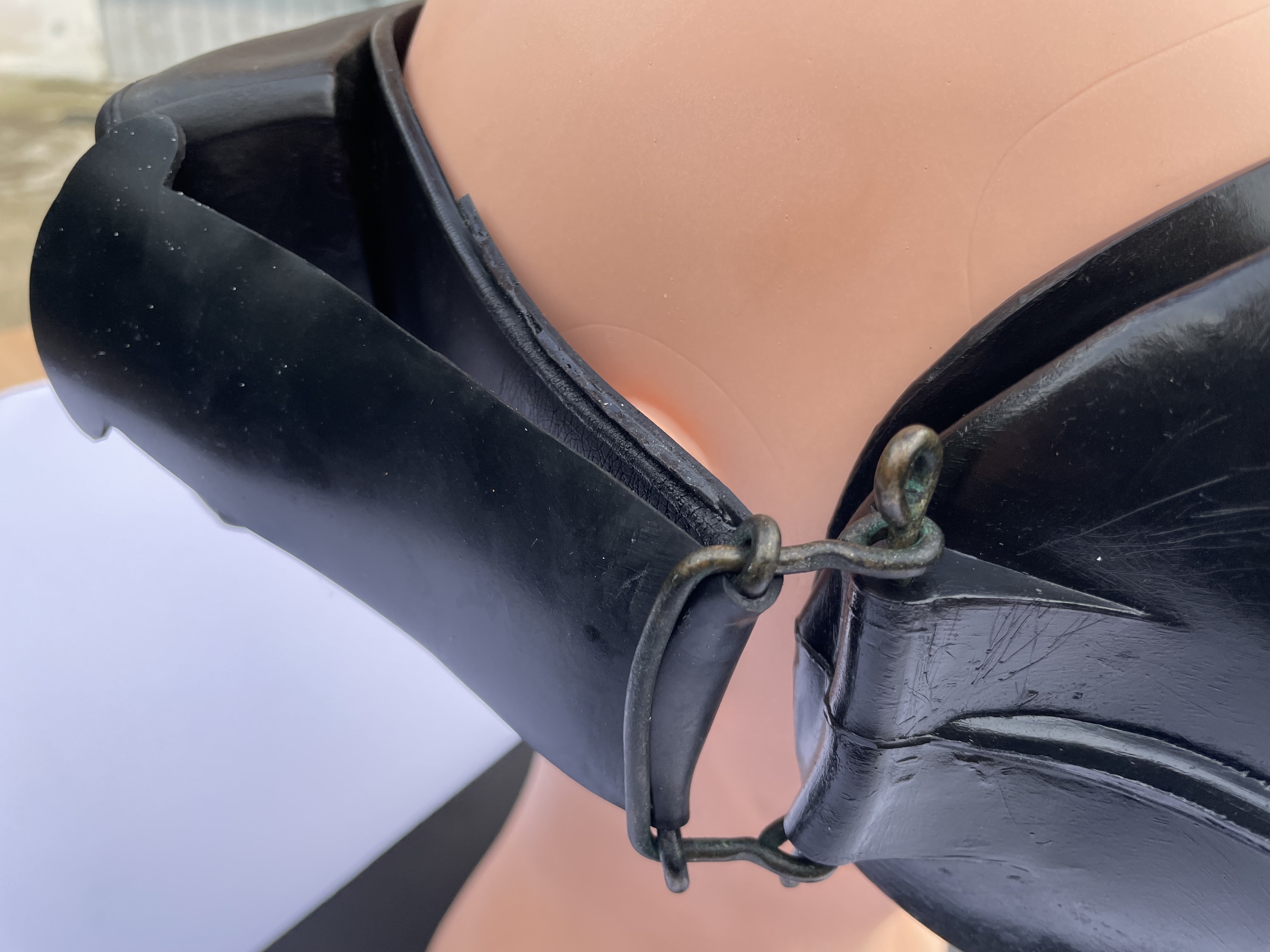 |
| Figure 47 |
Figure 48 |
This magnificent example of the production of equipment from the diving pioneering time is now returned to the admiration of enthusiasts of sport diving history who will have the opportunity to visit my little museum in Gubbio.



















